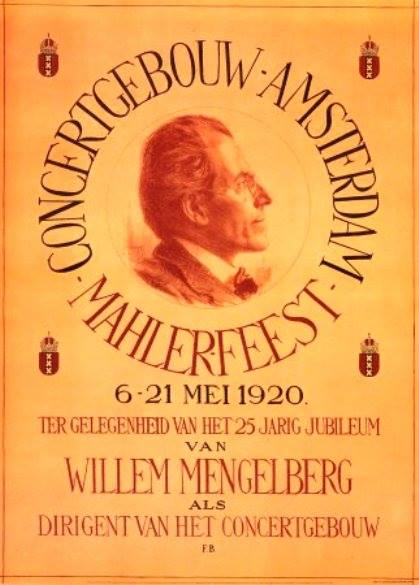First Mahler Festival in Amsterdam. On the occasion of the 25th anniversary of Willem Mengelberg (1871-1951) at the Amsterdam Royal Concertgebouw Orchestra (RCO).
“On the day we jubilate Willem Mengelberg, a ray of the sun from the festival will illuminate a grave on the edge of Vienna and a glowing simple tombstone will send its greetings back to Holland: A greeting of Gustav Mahler to his heirs” – Vienna, 1919 – Gertrude Forstel (1880-1950)
1920. Gustav Mahler Festival Amsterdam 1920. Program book, Amsterdam, the Netherlands. Translation from Dutch: “Royal Concertgebouw, Amsterdam, Mahler Feest (Fest, Festival) from may 6 until may 21 1920. To mark the 25th anniversary of Willem Mengelberg (1871-1951) as conductor of the Royal Concertgebouw Orchestra (RCO/KCO)“.
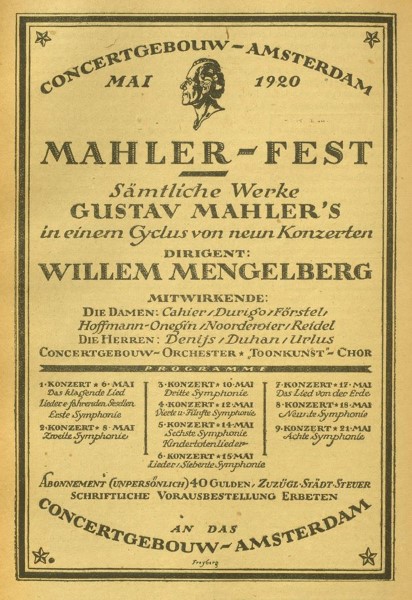
1920. Gustav Mahler Festival Amsterdam 1920. Program in German.
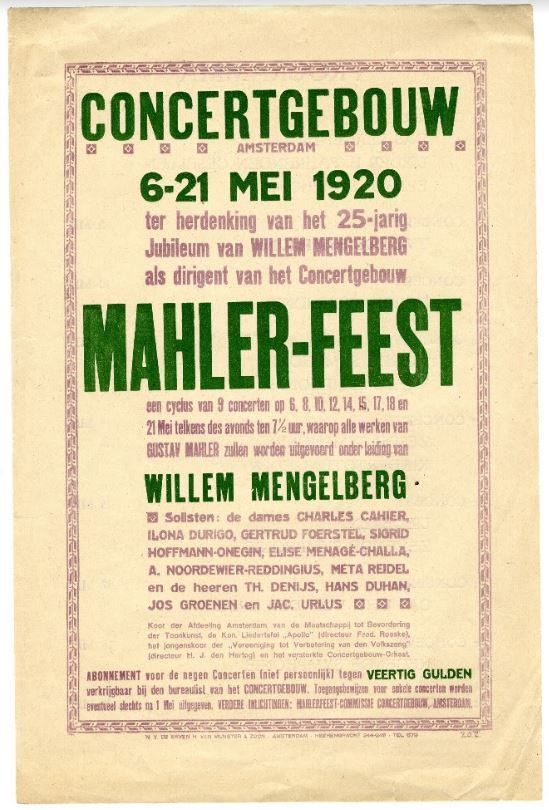
01-05-1920. Gustav Mahler Festival Amsterdam 1920. Advertisement in De Kunst magazine.
Relevant
- Amsterdam Royal Concertgebouw (1883).
- Amsterdam Royal Concertgebouw Orchestra (1888).
- Gustav Mahler himself in the Netherlands (1903, 1904, 1906, 1909 and 1910).
- Mahler Festival 1995 Amsterdam.
- Mahler Festival 2020 Amsterdam.
- Gustav Mahler Festival Amsterdam 2020.
- Willem Mengelberg (1871-1951).
1920 Program
All concerts by the Royal Concertgebouw Orchestra (RCO/KCO), conductor Willem Mengelberg (1871-1951) in the Royal Concertgebouw.
- 24-04-1920 Amsterdam: Amsterdam Royal Concertgebouw. Saturday. Honoring day. Composition “Feast Cantata” by Cornelis Dopper (1870-1939). Prince Hendrik on the stage. Mathilde Mengelberg-Wubbe (1875-1943). Triumphal arch. Composition “Welkomsgroet” by Catharina van Rennes. Composition “Mengelbergcantata” by Cornelis Dopper (1870-1939). Many speeches. Handing over the Commemorative book by Paul Cronheim. Seven enormous books with many personal contributions are bound by C. J. Mensing in Bussum in levantine morocco (a fine kind of goat leather from Morocco). On the back of 6 green books are the first 13 bars of Mahler’s Symphony no. 3 as characteristic of the person Mengelberg: “Kraftig und entschiedend”. Book 7 is brown and contains the contributions of the visual artists. On the back are golden stamps, which are cut into copper by Mensing. The seven books are stored and a nice cabinet, made by the NV Meubelfabriek v. H. Le Cointre and Co. from The Hague. A shorter (green) Trade edition has also been made. Ending of the evening with Halleluja from The Messiah (Georg Friedrich Handel (1685-1759)). Amsterdam Royal Concertgebouw Orchestra (RCO) and Toonkunst choir.
- 25-04-1920
- 26-04-1920
- 27-04-1920
- 28-04-1920
- 29-04-1920
- 30-04-1920 Amsterdam: Amsterdam Royal Concertgebouw. Friday. First lecture in the small hall by Dr. A.H. de Hartog.
- 01-05-1920
- 02-05-1920
- 03-05-1920
- 04-05-1920 Amsterdam: Amsterdam Royal Concertgebouw. Plants in front of the building, flag on top and inside azaleas. Behind Mengelberg’s podium stands the bust of Mahler, in the bookshops and music shops Mahler’s scores and the Mengelberg Memorial Book are prominently displayed, little statues of Mahler and Mengelberg adorn the windows sills of Amsterdam, the trams to the Concertgebouw fly flag in the national tri-colour and declare their destination to be ‘Mahler Festival Concertgebouw’.
- 05-05-1920 Amsterdam: Amsterdam Royal Concertgebouw. Wednesday. General rehearsal for the first concert. Guests were welcome at the rehearsal as “Guest of the committee”.
- 06-05-1920 Amsterdam: Amsterdam Royal Concertgebouw. Thursday. Flowers and palms on the stage. In front of the conductor’s desk is a bust of Gustav Mahler by Georgine Schwartze (1854-1935), after a model by Rodin. Shops have decorated shop windows. The trams have flags and inscriptions. Many ladies are beautifully dressed in gala, the gentlemen in skirt and tuxedo. A lot of prominent people and journalists. Das klagende Lied and Lieder eines fahrenden Gesellen and Symphony No. 1. Mengelberg invited two soprano’s (Gertrude Forstel (1880-1950) and Aaltje Noordewier-Reddingius (1868-1949)) for Das klagende Lied, like Gustav Mahler did, but Aaltje Noordewier-Reddingius (1868-1949) became ill. Gertrude Forstel (1880-1950) was the only soprano that evening. Jacques Urlus. Mengelberg himself was not yet fully recovered from the inflammation on his arm. Accessible to the general public.
- 07-05-1920 Amsterdam: Amsterdam Royal Concertgebouw. Friday. Three lectures in the small hall (2.30 pm):
- 1. “Gustav Mahlers Sieg” by Richard Specht (1870-1932). The Triumph of Gustav Mahler.
- 2. “Gustav Mahlers Personlichkeit” by Guido Adler (1855-1941). The Personality of Gustav Mahler
- 3. “Festrede” by Alfredo Casella (1883-1947). Festival Address
- 08-05-1920 Amsterdam: Amsterdam Royal Concertgebouw. Saturday. Symphony No. 2. Elise Menage-Challa (Finale), Sigrid Hofmann-Onegin (alto Urlicht) and Meta Reidel (alto Finale). Alma Mahler (1879-1964) and Anna Justine Mahler (Gucki) (1904-1988) (aged 16) present. Concert was accessible to the general public. Afterwards a Tribute by a delegation of the Frankfurt orchestra (Hans Lange, Kurt Mochel, Max Grassler and Karl Vater). Kurt Mochel spoke in the Conductors Room.
- 09-05-1920 Amsterdam: Amsterdam Royal Concertgebouw. Sunday. In the morning a aubade in front of House Willem Mengelberg. Mengelberg and his wife at the balcony with Antonie Roell (1864-1940), Richard van Rees (1853-1939), Charles Ernest Henri Boissevain (1868-1940), Hendrik Jan de Marez Oyens (1843-1911), Jo Beukers-van Ogtrop (1865-1948) and later also Alma Mahler (1879-1964) and Anna Justine Mahler (Gucki) (1904-1988). Alma Mahler (1879-1964) gave the Manuscript Symphony No. 7 as a present to Mengelberg. Rainy. Afterwards he invited the musicians to come upstairs to have a drink. Alma Mahler (1879-1964) went to the Amsterdam railway station for the arrival of Arnold Schoenberg (1874-1951) and to bring him to Mengelberg.
- 09-05-1920 Amsterdam: Amsterdam Royal Concertgebouw. In the afternoon first concert of “International Chambermusic festival during the Mahler Festival“. Five concerts organised by (see) Alexander Schmuller (1880-1933). Small hall. In the evening rehearsal for Symphony No. 3.
- 10-05-1920 Amsterdam: Amsterdam Royal Concertgebouw. Monday. Symphony No. 3. Meta Reidel (alto). Accessible to the general public.
- 11-05-1920 Amsterdam: Amsterdam Royal Concertgebouw. Tuesday. In the evening second concert of “International Chambermusic festival during the Mahler Festival”. Five concerts organised by Alexander Schmuller (1880-1933). Small hall.
- 12-05-1920 Amsterdam: Amsterdam Royal Concertgebouw. Wednesday. Message from the Municipality of Utrecht that a street is named after Mengelberg in his hometown Utrecht: Mengelberglaan. Symphony No. 4 Gertrude Forstel (1880-1950) and Symphony No. 5.
- 13-05-1920 Amsterdam: Thursday. Ascension Day. No concerts. 250 Foreign guests make a trip to visit the SS Jan Pieterszoon Coen. Departure from the jetty of the Noord-Hollandse tram. Leaving 2.30 pm. Reception at the Coen by the Association to Broaden the knowledge of the Netherlands. Music on board. Viewing of the ship in groups. Tea in the reception room. Speeches. Including one of Egon Wellesz (1885-1974) on behalf of the foreign guests. Attended by Alma Mahler (1879-1964), Gertrude Foerstel, Sarah Charles Cahier (1870-1951), Arnold Schoenberg (1874-1951), Richard Specht (1870-1932) and Paul Stefan (1879-1943). At 5 pm back in the city.
- 14-05-1920 Amsterdam: Amsterdam Royal Concertgebouw. Friday. Symphony No. 6 and Kindertotenlieder. Soloists: Ilona Durigo and Jacques Urlus. Baritone Hans Duhan (Vienna) was ill. Two lectures in the small hall (2.30 pm): Gustav Mahler und die Wiener Oper.
- 1. “Gustav Mahler und das Theater” by Paul Stefan (1879-1943). Gustav Mahler and the Theater.
- 2. “Wien und die Musik” by Felix Salten. Vienna and Music.
- 15-05-1920 Amsterdam: Amsterdam Royal Concertgebouw. Saturday. In the morning was a personal tour by the director of het Rijksmuseum (Mr. B.W.F. van Riemsdijk) for the guests. Lied 5: Das irdische Leben and Lied Ruckert 2: Ich atmet’ einen linden Duft and Lied 4: Wer hat dies Liedlein erdacht? by Ilona Durigo and Lied Ruckert 3: Um Mitternacht and Lied Ruckert 4: Ich bin der Welt abhanden gekommen by Aaltje Noordewier-Reddingius (1868-1949) and Symphony No. 7.
- 16-05-1920 Haarlem: Sunday. Reception in Haarlem by Antonie Roell (1864-1940) in his house on the Nieuwe Gracht. 200 visitors. With Alma Mahler (1879-1964), Mathilde Mengelberg-Wubbe (1875-1943), Arnold Schoenberg (1874-1951), Alexander Schmuller (1880-1933), Leonid Kreutzer (1884-1953) and his wife, Adolf Busch, Sarah Charles Cahier (1870-1951), Ilona Durigo and Gertrude Forstel (1880-1950).
- 16-05-1920 Amsterdam: Amsterdam Royal Concertgebouw. Sunday. In the evening third concert of “International Chambermusic festival during the Mahler Festival”. Five concerts organised by Alexander Schmuller (1880-1933). Small hall.
- 17-05-1920 Amsterdam: Amsterdam Royal Concertgebouw. Monday. Visit to the diamond grinding, company of Asscher. Das Lied von der Erde. Sarah Charles Cahier (1870-1951) and Jacques Urlus.
- 18-05-1920 Amsterdam: Amsterdam Royal Concertgebouw. Tuesday. Symphony No. 9. Death day 18-05-1911 Gustav Mahler (1860-1911).
- 19-05-1920 Amsterdam: Wednesday. Boattrip through Amsterdam harbours offered by the City Council of Amsterdam to the foreign guests. Departure 2 pm from De Ruyterkade jetty No. 9 with members of the board and musicians of the Amsterdam Royal Concertgebouw Orchestra (RCO), Alma Mahler (1879-1964), Gertrude Forstel (1880-1950), Mathilde Mengelberg-Wubbe (1875-1943), Jo Beukers-van Ogtrop (1865-1948), Arnold Schoenberg (1874-1951), Florent Schmitt, Johan Halvorsen, Adolf Busch, Marix Loevensohn, Oscar Bie (1864-1938), Richard van Rees (1853-1939), Gerrit Hendrik de Marez Oyens (1811-1883) and members of the municipal administration (aldermen De Vlugt, Wibaut and HJ Hertog) etc. Destination Pampus Island and Eastern docks. Meeting between Schoenberg and the French composer Florent Schmitt. Arrival back in the city at 6.00 pm. Weather was fine.
- 19-05-1920 Amsterdam: Amsterdam Royal Concertgebouw. Wednesday. In the evening fourth concert of “International Chambermusic festival during the Mahler Festival”. Five concerts organised by Alexander Schmuller (1880-1933). Small hall.
- 20-05-1920 Amsterdam: Amsterdam Royal Concertgebouw. Thursday. In the afternoon fifth concert of “International Chambermusic festival during the Mahler Festival”. Five concerts organised by Alexander Schmuller (1880-1933). Small hall.
- 21-05-1920 Amsterdam: Amsterdam Royal Concertgebouw. Friday. Symphony No. 8. At this closing evening the orchestra had the largest scale of 166 musicians. Gertrude Forstel (1880-1950), Aaltje Noordewier-Reddingius (1868-1949), Sarah Charles Cahier (1870-1951), Ilona Durigo (alto), Jacques Urlus (tenor), Jos. Groenen baritone), Thom. Denijs (bas). Choirs: Toonkunst choir, Liedertafel Apollo, Volkszang, Kunst en Arbeid. With special guests in the orchestra: Oskar Back, Carl Flesch (1st violins), Alexander Schmuller (1880-1933) and Felix Togni (2nd violins), Adolf Busch, Hans Lange, Hendrik Rijnbergen to the already reinforced ranks of the string section, while Louis Robert sat at the organ, Cornelis Dopper (1870-1939) played the harmonium, and no lesser figure than Leonid Kreutzer (1884-1953) took charge of the piano part.
- Creation of a Mengelberg Fund that would come into force only after his death. First the fund would be used as a pension provision from the age of sixty. Signing of manifesto by the foreign guests of nine nations in the large hall. Presented by Cesar Saerchinger to chairman Antonie Roell (1864-1940). In the resolution they thanked the organization of the festival and expressed the hope that this would also result in other international events where artists from all countries could meet. Mengelberg provisionally accepted the presidency of the committee that had to realize this. During this meeting, after a speech by Hendrik Freijer (1876-1955), two plaquettes, designed by sculptor Toon Dupuis (1877-1937) (and executed by the firm Begeer) were unveiled with the effigies of Mahler and Mengelberg. Mengelberg gave a bronze medal to foreign visitors. See photos. Establishment of the Mahlerbund, aimed at the propaganda of Mahler’s music. Alma Mahler (1879-1964) honorary chairman, Arnold Schoenberg (1874-1951) chairman and Willem Mengelberg (1871-1951) patron. Accessible to the general public.
- 22-05-1920 Amsterdam: Amsterdam Royal Concertgebouw. Saturday. Closing party dinner in the Concertgebouw. Alma Mahler (1879-1964) sits opposite Prince Henry of the Netherlands (1876-1934) and between Willem Mengelberg (1871-1951) and Arnold Schoenberg (1874-1951). Offering by Antonie Roell (1864-1940) of a bust of Willem Mengelberg (1871-1951) to Mengelberg made by the deaf and dumb visual artist Gustinus Ambrosi during the festival. Four copies would be cast: for Willem Mengelberg (1871-1951), Amsterdam Royal Concertgebouw, Frankfurter Museumgesellschaft and for the Amsterdam Stedelijk museum. The organizing committee receives a telegram by the Austrian chancellor Karl Renner on the occasion of the successful Mahler Festival and to expresses its gratitude for the tribute to Gustav Mahler and the honor of Austrian music. Alderman Den Hertog announced that the Amsterdam city government intended to rename two streets near the Concertgebouw to Willem Mengelbergstraat and Willem Mengelbergplein.
Soloists
- Aaltje Noordewier-Reddingius (1868-1949) (soprano).
- Sarah Charles Cahier (1870-1951) (alto). In 1911 at the first performance of Das Lied von der Erde, she performed the solos.
- Adolf Busch (violin).
- Alexander Schmuller (1880-1933) (violin).
- Alfredo Casella (1883-1947) (piano).
- Carl Flesch (violin).
- Charles Cahier (alto).
- Cornelis Dopper (harmonium).
- Cyril Scott (piano).
- Dirk Speets (trumpet). Amsterdam Royal Concertgebouw Orchestra (RCO).
- Elise Menage Challa (soprano). Amsterdam.
- Gertrude Forstel (1880-1950) (soprano).
- Gerard von Brucken Fock (piano).
- Haagmans (trombone, tenor horn). Amsterdam Royal Concertgebouw Orchestra (RCO).
- Hans Duhan (baritone). 1890 Vienna. Kindertotenlieder were sung on 14-05-1920 by Ilona Durigo because Duhan was ill.
- Ilona Durigo (alto). 1881 Budapest)
- Jacques Urlus (tenor). 1867 Aachen, youth in Tilburg.
- Joseph Groenen (baritone). Jos. Groenen. 1885 in Waalwijk.
- Judith Bokor (violoncel).
- Leonid Kreutzer (1884-1953) (piano).
- Louis Robert (organ). 1882 Haarlem.
- Louis Zimmermann (violin). Amsterdam Royal Concertgebouw Orchestra (RCO).
- Marix Loevensohn (violoncel). Amsterdam Royal Concertgebouw Orchestra (RCO).
- Meta Reidel (alto). Amsterdam.
- Moritz Loevensohn (violoncel).
- Oscar Back (violin).
- Sigrid Hoffmann-Onegin (alto). Stockholm.
- Thom. Denijs (bas). 03-01-1877 Schagen.
- Willem Andriessen (piano).
Non-soloists
- Apollo choir. Director: Fred. Roeske.
- Bohemian String Quartet (De Bohemers: Hoffmann, Suk, Herold, Zelenka).
- Boys choir ‘Volkszang’. Director Herman Johannes den Hertog. 13-03-1872 Haarlemmermeer. Also participated in 1903 Concert Amsterdam 22-10-1903 – Symphony No. 3, 1903 Concert Amsterdam 23-10-1903 – Symphony No. 3 conducted by Gustav Mahler. At the festival Symphony No. 3 and Symphony No. 8.
- Dutch String Quartet (Hollandsche Strijkkwartet: Leydensdorff, Mendes, Kint, Canivez).
- Madrigaal Vereniging.
- Male choir ‘Kunst na Arbeid’.
- Toonkunst choir.
Orchestra
Conductor
- Willem Mengelberg (1871-1951).
- Cornelis Dopper (1870-1939) Second conductor, rehearsals
1920 Special guests, present
- Alexander Schmuller (1880-1933) (violinist).
- Alfred Eduard Rose (1902-1975) (nephew of Gustav Mahler).
- Alfredo Casella (1883-1947) (composer).
- Alma Mahler (1879-1964) (widow of Gustav Mahler). Manuscript Symphony No. 7.
- Alphons Diepenbrock (1862-1921) (composer). Friend of Gustav Mahler). Husband of Elsa Diepenbrock (1868-1939).
- Anna Justine Mahler (Gucki) (1904-1988) (daughter of Gustav Mahler).
- Anton van Rooy (1870-1932) (singer).
- Anton Webern (1883-1945) (composer).
- Arnold Josef Rose (1863-1946) (brother in law).
- Arnold Schoenberg (1874-1951) (composer). Friend of Gustav Mahler.
- Bernard Zweers (1854-1924) (composer).
- Carl Julius Rudolf Moll (1861-1945) (Alma Mahler’s stepfather).
- Carl Nielsen (1865-1931) (composer). Late arrival. Was impressed.
- Egon Wellesz (1885-1974) (musicologist).
- Emil Hertzka (1869-1932) (Viennese chef of Universal Edition (UE) music publishers). Late arrival.
- Erwin Stein (1885-1958) (composer).
- Gertrude Forstel (1880-1950) (soprano). She sang in the Vienna Hofopera 1906-1912, known from her solo’s in Symphony No. 4.
- Guido Adler (1855-1941) (fmusic historian). Friend of Gustav Mahler.
- Johan Wagenaar (1862-1941) (composer).
- Justine (Ernestine) Rose-Mahler (1868-1938) (sister of Gustav Mahler).
- Leonid Kreutzer (1884-1953) (pianist). With his wife.
- Mathilde Mengelberg-Wubbe (1875-1943) (wife of Willem Mengelberg (1871-1951).
- Nadia Boulanger (1887-1979). (Composer, conductor). Late arrival.
- Oskar Bie (1864-1938) (conductor).
- Otto Klemperer (1885-1973) (conductor).
- Paul Stefan (1879-1943) (Mahler connoisseur).
- Prince Henry of the Netherlands (1876-1934). In a special place on the balcony.
- Richard Specht (1870-1932) (biographer of Gustav Mahler).
- Rudolf Mengelberg (1892-1959) (composer).
- Willem Mengelberg (1871-1951) (conductor). Jubilaris, friend of Gustav Mahler.
- Adolf Busch (composer).
- Adrian Boult (conductor). Late arrival. Teacher Royal Acedemy. Attended rehearsals. Wrote article for the Daily Telegraph in which he stated that Mengelberg was the musical executor-testamentary of Mahler’s musical legacy.
- Alfred Hertz (conductor) and wife. From San Francisco.
- Arthur Schnabel (conductor).
- Catharina van Rennes (composer).
- Cesar Searchinger (correspondent Musical Courier, America).
- Chevalley (publicist). Hamburg.
- De Paul Gilson (composer).
- Emmy Wellesz (art historian).
- Erich Kleiber (1890-1959) (conductor).
- Felicien Bobeldijk (artist).
- Felix Salten (writer).
- Ferdinand (?) Schmutzer Jr. (etcher). Vienna. See Maria Caroline Rosé-Schmutzer (1909-1999).
- Floor Wibaut (alderman Amsterdam).
- Florent Schmitt (composer).
- Francois Rasse (composer). Late arrival, Belgium.
- Frederic Lamond (pianist). Late arrival.
- Hermann Abendroth (conductor). Cologne.
- Herman den Hertog (alderman Amsterdam).
- Gerard von Brucken Fock (composer). The Netherlands.
- Guido Bagier (composer).
- Jan van Gilse (composer).
- Johan Halvorsen (1864-1935) (composer, conductor, violinist).
- Josef Suk (composer, violonist).
- Julius Rabe (1890-1969) (critic).
- Julius Rontgen (1855-1932) (composer).
- Kor Kuiler (composer).
- Mrs. Lanier (president Society of Friends of Music from New York).
- Lodewijk Mortelmans (conductor, composer). Late arrival. Belgium.
- Marix Loevensohn (violoncel player).
- Mathilde Schoenberg (1877-1923) (wife of Arnold Schoenberg, sister of Alexander von Zemlinsky (1871-1942)),
- Max Unger (musicologist). Leipzig.
- Olga Samaroff-Stokowski (1882-1948) (pianist).
- Paul Scheinpflug (composer). Late arrival.
- Peter van Anrooy (composer).
- Robert Musil (1880-1942) (writer). Attended rehearsal Symphony No. 7.
- Samuel Langford (1863-1972) (critic).
- Sem Dresden (composer). Dutch pianist. Pupil of Hans Pfitzner (1869-1949).
- Willem Mengelberg (1871-1951)‘s relatives from Germany (including his mother).
- Willem Pijper (1894-1947) (composer).
- Willem Royaards (theater director).
- Willem van Konijnenburg (artist).
- Willem de Vlugt (alderman Amsterdam).
1920 Special guests, invitation, not present
- Bruno Walter (1876-1962) (conductor, friend of Gustav Mahler). Due to commitments in Munich.
- Franz Werfel (1890-1945) (3th husband of Alma Mahler (1879-1964)). Did not get the invitation in time. Alma Mahler (1879-1964) found his invitation on her way to Amsterdam.
- Edward Elgar (composer).
1920 No invitation?
- Anna Bahr-von Mildenburg (1872-1947)
- Ferruccio Busoni (1866-1924)
- Margaretha Rita Merlitschek-Michalek (1875-1944)
- Marie Gutheil-Schoder (1874-1935)
- Natalie Bauer-Lechner (1858-1921)
- Selma Kurz (1874-1933)
Manuscript
- 1920: Manuscript Symphony No. 7 given by Alma Mahler (1879-1964) to Willem Mengelberg (1871-1951) at Gustav Mahler Festival Amsterdam 1920.
Additional
- First Mahler Festival ever.
- In 11-1919 invitations were sent.
- From the early spring of 1920 advertisements appeared in all the major european newspapers and periodicals.
- Ticket sales started 16-12-1919. In 01-1920 already 600 passe-partouts sold. High prices. 30-40 guilders. After protest in Het Volk by Paul F. Sanders four general rehearsals open to the public were added. Called ‘Popular Concerts’.
- 150 foreign guests. From arrival to departure everything was organized per guest to the finest detail (reception at the Amsterdam railway station, baggage, loggings (some in hotels and others in private homes). There one found tickets for the concerts and the programme book. See Alma Mahler herself in the Netherlands (1912, 1920 and 1938). Welcome at rehearsals.
- Rehearsals until 11 pm. Some parts Willem Mengelberg (1871-1951) played through six times.
- Throughout the festival there was a bust of Mahler (made by Georgine Schwartze (1854-1935)) surrounded by flowers in front of the conductor’s box.
- “International Chambermusic festival during the Mahler Festival” in the small hall consisting of 5 concerts. Organised by Alexander Schmuller (1880-1933).
- Lectures in the small hall by Dr. A.H. de Hartog, Alfredo Casella (1883-1947), Guido Adler (1855-1941), Richard Specht (1870-1932), Paul Stefan (1879-1943) and Felix Salten. 30-04-1920, 07-05-1920 and 14-05-1920.
- “Readingmuseum” in Arti et Amicitiae.
- The festival ended with Symphony No. 8. Symphony No. 9 was not performed. At the time Symphony No. 9 was still seen as Mahler’s swansong (sketches for the incomplete Symphony No. 10 were not published until 1923), and was played on the anniversary of Mahler’s death, 15-05 with the earnest request that the audience withhold their applause at the end of the concert in memory of the composer.
- start time of the concerts 7.30 pm.
- Afterwards the Festival was characterization as “Peace Conference of Amsterdam” because participants from so many different countries found each other in a sharing a universal feeling.
- The foreign press: ‘Gustav Mahler’s Bayreuth’.
- 07-06-1920 Amsterdam: Boattrip on the Zuiderzee offered by Willem Mengelberg (1871-1951) and Mathilde Mengelberg-Wubbe (1875-1943) to the members of the Royal Concertgebouw Orchestra (RCO/KCO) and the members of the administrative staff of the Royal Concertgebouw. Zuiderzee is visited by Gustav Mahler in 1906.
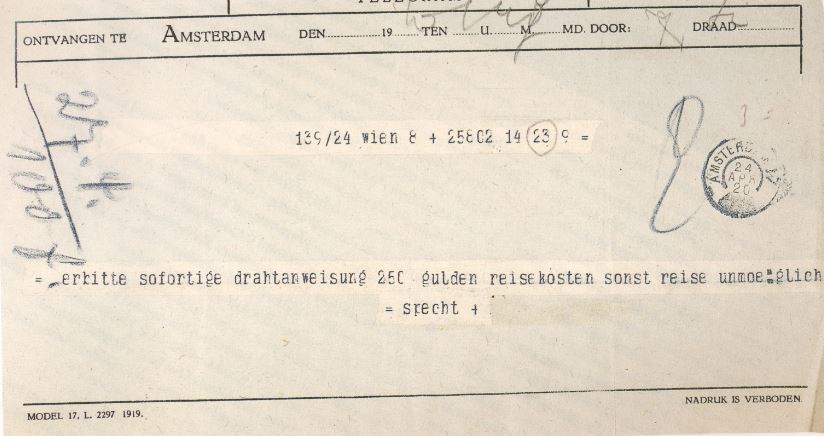
27-04-1920. Telegram of Richard Specht (1870-1932), claiming expenses for his trip to the Gustav Mahler Festival Amsterdam 1920. ‘Otherwise voyage not possible’.
01-05-1920. Gustav Mahler Festival Amsterdam 1920. Preview in De Kunst (the Arts) magazine.
01-05-1920. Gustav Mahler Festival Amsterdam 1920. Advertisement in De Kunst magazine.
1920. Gustav Mahler Festival Amsterdam 1920. Passe-partouts, series.
1920. Gustav Mahler Festival Amsterdam 1920. Passe-partouts, ticket, row- and seatnumber.
1920. Gustav Mahler Festival Amsterdam 1920. Alma Mahler (1879-1964) and Anna Justine Mahler (Gucki) (1904-1988) stayed in the house of the widow of Hendrik Jan de Marez Oyens (1843-1911). Museumplein No. 6 (6-8). Demolised. Now the location of the Van Gogh Museum. Photo 1963.
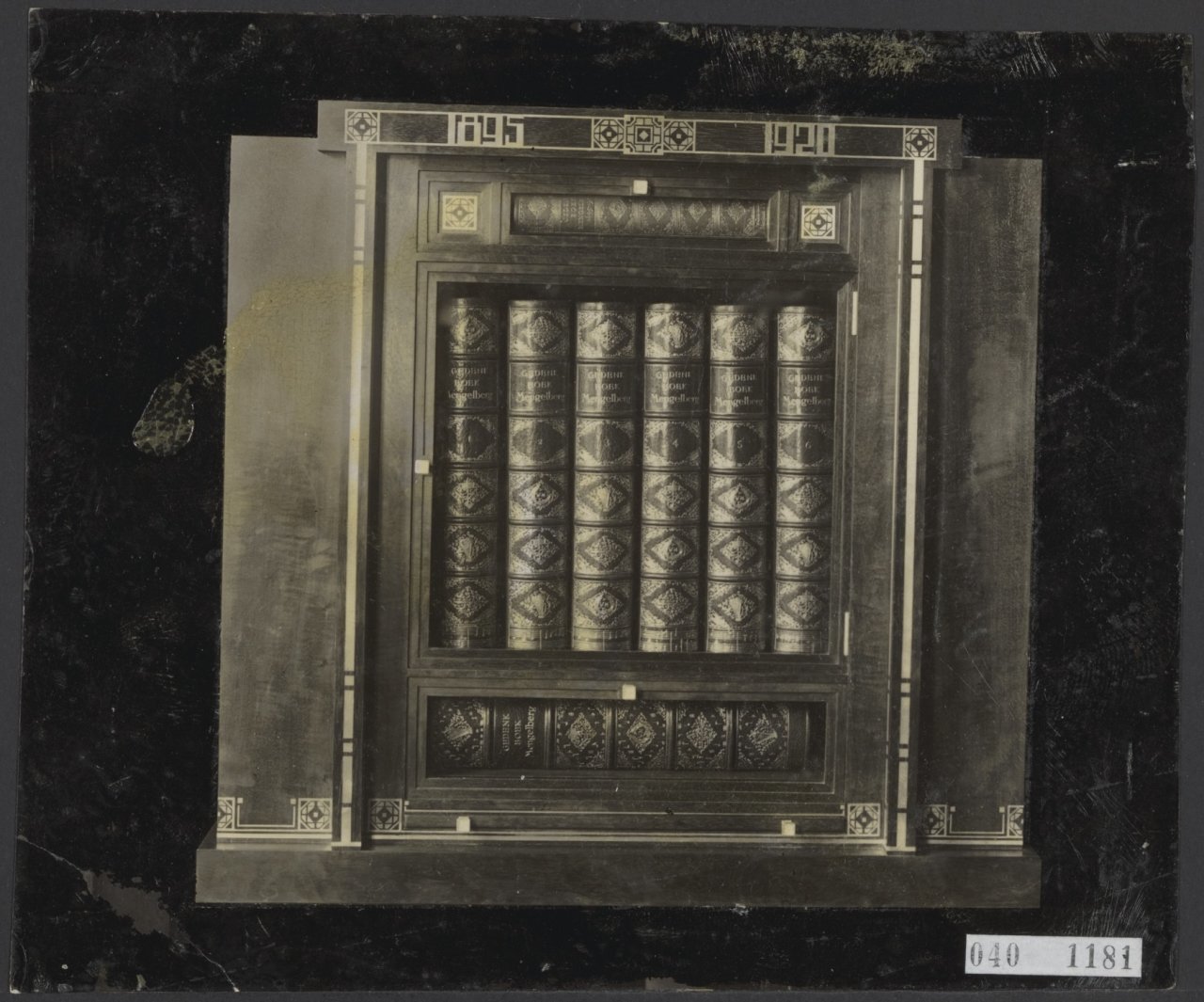
24-04-1920. Gustav Mahler Festival Amsterdam 1920. Commemorative book. Seven enormous books with many personal contributions are bound by C. J. Mensing in Bussum in levantine morocco (a fine kind of goat leather from Morocco). On the back of 6 green books are the first 13 bars of Mahler’s Symphony no. 3 as characteristic of the person Mengelberg: “Kraftig und entschiedend”. Book 7 is brown and contains the contributions of the visual artists. On the back are golden stamps, which are cut into copper by Mensing. The seven books are stored and a cabinet, made by the NV Meubelfabriek v. H. Le Cointre and Co. from The Hague.

24-04-1920. Gustav Mahler Festival Amsterdam 1920. Willem Mengelberg (1871-1951). Gedenkboek. Commemorative book. 1895-1920. Trade edition. Publisher Martinus Nijhoff (1920), The Hague. Creed: “MN Alles Komt Teregt”. 5 French and 50 German contributions.
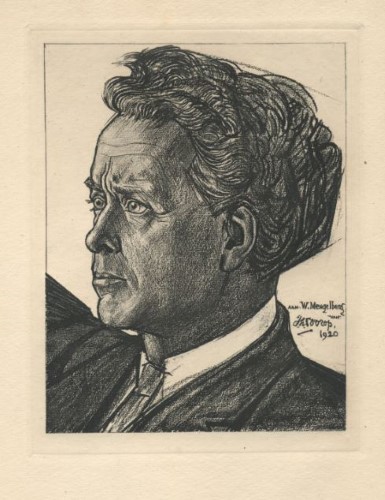
24-04-1920. Gustav Mahler Festival Amsterdam 1920. Willem Mengelberg (1871-1951). Gedenkboek. Commemorative book. 1895-1920. Trade edition. Publisher Martinus Nijhoff (1920), The Hague. Willem Mengelberg (1871-1951) by Jan Toorop (1858-1928).
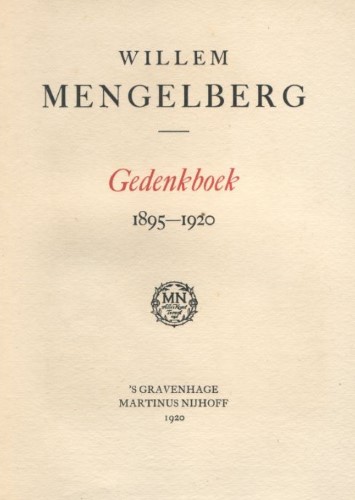
24-04-1920. Gustav Mahler Festival Amsterdam 1920. Willem Mengelberg (1871-1951). Gedenkboek. Commemorative book. 1895-1920. Trade edition. Publisher Martinus Nijhoff (1920), The Hague.
- Contribitors only in the original cassettes: Ant. Averkamp, E.L. Bainton, Waldemar von Baussnern, H. Becker, Hendrik (Han Henri) de Booy (1867-1964), G.H.G. Brucken Fock, Lion Cachet, Carlo Clausetti, G.B. Crommelin, E. Dooseman-Vigeveno, Franz Drdla, Mej. Joh. Dusault, Fred van Eeden, J.C. van Epen, P.N. van Eyck, Le Fauconnier, Max Fiedler, Ed. Gerdes, J.C. Gijsberti Hodenpijl van Hodenpijl, A.P. Haan-Manifarges, Louis Hartz, Siegmund Hausegger, H.J. Haverman, E. Bysterus Heemskerk, G. Henkes, Sir George Henschel, Mej. Myra Hess, Isaac Israels, Maria Ivogun, L. Jessurun de Mesquita, Ludwig Kainer, W. Kleefeld, Erich Wolfgang Korngold (1897-1957), H. Kroller-Muller, R. von Kuhlmann, Otto Lanz, Chris Lebeau, Lilli Lehmann (1848-1929), J.H.W. Leliman, Otto Lies, Otto Lohse (1858-1925), Nicolas Manskopf, Mrs. M.C. de Marez-Oyens-Reynvaan, Justizrat H. Mengelberg, Herman Moerkerk, Pierre Monteux, Anita Moor, D.B. Nanninga, Walter Niemann, Arthur Nikisch (1855-1922), Cornelie van Oosterzee, Jos M. Orelio, M.W. Petri, Catharina van Rennes, F.J. Roeske, Landon Ronald, Engelbert Rontgen, Anton van Rooy (1870-1932), Lene Schneider-Kainer, Johan Schoonderbeek, Franz Schreker (1878-1934), Georg Schumann, Georgine Schwartze (1854-1935), Alexander Siloti, Jan Sluyters, Leopold Stokowsky, Ewald Straesser, Hermann Suter, Christiaan Timmner, Vincenzo Tommasini, M.W. v.d. Valk, A.B.H. Verheij, Tjipke Visser, Mej. E. Vissering, Bruno Walter (1876-1962), Georg A. Walter, Mej. Cornelie van Zanten, J.A.H. Zuylen van Nijvelt, Bernard Zweers (1854-1924).
- Contributors in trade edition: Queen Wilhelmina (signature 21-11-1919), Queen consort Emma (signature), Prince Henry of the Netherlands (1876-1934) (signature), A.M. Abell (New York, 12-1919), Guido Adler (1855-1941) (Vienna, 01-1920), Eugen d’Albert (1864-1932) (Lugano, Christmas 1919), Willem Andriessen, Peter van Anrooy (Scheveningen, 11-1919), Nicola d’Atri (Rome, 11-1919), Harold Bauer (New York, 12-1919), Marius Bauer (drawing), H.P. Berlage (drawing), J.G. Beukers (poem), Jo Beukers-van Ogtrop (1865-1948), P.J. Blok (Leiden, 11-1919), F. Bobeldijk (drawing), Arthur Bodanzky (1877-1939) (New York, 01-1920), De Bohemers (Het Boheems Strijkkwartet, The Bohemian String Quartet (Prague, 08-01-1920), Charles Ernest Henri Boissevain (1868-1940), Betsy Bonger, Jan Boon (drawing), S. Bottenheim (statistics, Amsterdam, 07-1919), A. Bredius (letter from mayor Leiden to Jan Pietersz Sweeling, 06-1616), Alfred Breslauer (drawing), Adolf Busch (Berlin, 10-1919), Caecilien-Verein (Frankfurt, 01-1920), Lucien Carpet, Alfredo Casella (1883-1947) (Rome, 11-1919), P. Cort van der Linden, Louis Couperus (The Hague, 09-1919), Paul XII Cronheim (introduction), Julia Culp (Amsterdam, 12-1919), J.Th.J. Cuypers (drawing), P.J.H. Cuypers (drawing), Frank Damrosch (New York), Walter Johannes Damrosch (1862-1950) (New York, 01-1920), Mrs. Emma Claude Debussy (on photo 12-1919), Jan Dekker, C.C. Delprat (Amsterdam, 01-1920), Thom Denys, Alphons Diepenbrock (1862-1921) (Amsterdam, 01-1920), Cornelis Dopper (1870-1939) (Amsterdam, 10-1919), Jan Dudok van Heel (1867-1930), Paul Abraham Dukas (1865-1935) (Paris), M.I. Duparc, Ilona Durigo (composition), Edward Elgar (1857-1934) (composition, 20-11-1919), B. Essers (drawing), J.H. Fekkes (drawing), A. Fentener van Vlissingen (The Hague, 11-1919), Carl Flesch (Berlin, 11-1919), D. Fock (The Hague 10-1919), Dirk Fock Jr. (New York), Andrea Fockema, Gertrude Forstel (1880-1950) (Vienna, 1919), Frankfurter Museums Gesellschaft (Frankfurt am Main, 01-1920), Hendrik Freijer (1876-1955), Ossip Gabrilowitsch (1878-1936) (Detroit, 1920), Jan van Gilse (composition, Utrecht, 01-1920), A.M. Gorter (drawing), H.D. van Goudoever (composition), Percy Grainger (New York, 12-1919), Nina Grieg (letter from Edvard Grieg (1843-1907), Troldhaugen, 10-07-1898), Willem de Haan (composition, Darmstadt), A.H. Hartog (Amsterdam), Th. Heemskerk (10-1919), Ms.Marie Heller, H.J. den Hertog (Amsterdam, 04-1920), D. van Houten (The Hague, 1920), Wouter Hutschenruyter (Rotterdam, 10-1919), Vincent d’Indy (1851-1931) (composition), L. Jacobson (Rotterdam, 1920), Dirk Herbert Joosten (1840-1930) (Amsterdam, 11-1919), Max Kalbeck (1850-1921)(Salzburg, 12-1919), H.A. Karnebeek (12-1919), Ludwig Karpath (1866-1936) (Vienna, 12-1919), Hans Kindler (Philadelphia, 01-1920), A.B. Kleerekoper (Amsterdam, 01-1920), W. Kloos (12-1919), W.A. Konijnenburg (drawing, 1920), D. Kouwenaar (Amsterdam, 1920), Fritz Kreisler (1875-1962) (New York, 01-1920), Leonid Kreutzer (1884-1953) (Amsterdam, 11-1919), W. Kromhout Czn. (drawing), J. Kronig, R. Kruger (Amsterdam), K. Kuiper, Frederic Lamond (London, 10-1919), W. Landowska (08-11-1919), Peider Lansel (poem, 11-1919), A. van der Leeuw (poem), W.F. van Leeuwen, Marix Loevensohn (Amsterdam), H.A. Lorentz (lecture on Stronhal), J. Loudon (Paris), Alex C. Mackenzie (composition), Alma Mahler (1879-1964) (Vienna, 12-1919), Joan Manen (Madrid, 1920), Gerrit Hendrik de Marez Oyens (1811-1883) (Amsterdam, 12-1919), Hendrik Jan de Marez Oyens (1843-1911), (Noordwijk-aan-Zee, 09-1919), W.G. de Marez Oyens (The Hague, 10-1919), W. Martin (The Hague, 09-1919), A. Mendelssohn-Bartholdy (Wurzburg, 10-1920), Rudolf Mengelberg (1892-1959) (Amsterdam, 11-1919), Johannes Messchaert (1857-1922) (composition, Zurich, 17-12-1919), Carl Julius Rudolf Moll (1861-1945) (photo 1909-1911 House Carl Moll II Vienna – Wollergasse No. 10 with signature), Emanuel Moor (drawing, 1918), Jan Musch, Otto Neitzel (Cologne, 26-11-1919), Elly Ney-van Hoogstraten, Hugo Nolthenius (Laren, 09-1919), Aaltje Noordewier-Reddingius (1868-1949) (Hilversum, 12-1919), Sigrid Onegin (Munich, 12-1919), C. van Oort (Amsterdam, 11-1919), J. Oppenheim (The Hague, 01-1920), Emil Orlik (1870-1932) (drawing, 1919), J.A.N. Patijn (Hoog-Soeren, 09-1919), Josef Pembauer (Leipzig, 10-1919), Peters music publishers (Leipzig, composition of Max Reger), Gabriel Pierne (1863-1937) (Paris, 10-1919), L.J. Plemp van Duiveland, Giacomo Puccini (1858-1924) (Milan, 11-1919), Willem Pijper (1894-1947) (01-1920), E.D. Pijzel, Sergei Rachmaninoff (1873-1943) (composition), Richard van Rees (1853-1939) (Amsterdam, 10-1919), Elsa Reger (Jena, 02-1920), Ms. Meta Reidel (Amsterdam), S. de Rhemen van Remenshuyzen, Top van Rhijn-Naeff (poem), B.W.F van Riemsdijk (drawing), Antonie Roell (1864-1940) (Haarlem, 11-1919), Herman Roelvink, J.A.A. Roger-Ducasse (composition, 12-1919), R.N. Roland Holst (drawing), M. Romer (poem, Fuchshof, 10-1919), Julius Rontgen (1855-1932) (Amsterdam, 09-1919), Agatha Roos-Goldschmidt, Justine (Ernestine) Rose-Mahler (1868-1938) and Arnold Josef Rose (1863-1946) (violin solo from Lied 5: Der Trunkene im Fruhling), Wi. Royaards (Amsterdam, 1920), E. Comte de San Martino (Rome, 11-1919), A. de Savorin Lohman (The Hague, 12-1919), E.R.D. Schaap (drawing), Wera Schapira (Hamburg, 02-1920), Lodewijk Schelfhout (drawing), Max von Schillings (1868-1933) (composition, Berlin, 1919), Alexander Schmuller (1880-1933) (handwriting), Arthur Schnabel (Charlottenburg, 10-1919), Arthur Schnitzler (1862-1931) (Vienna, 10-1919), Arnold Schoenberg (1874-1951) (Vienna-Modling, 11-1919), J. Six, C. Snouck Hurgronje (composition for lute), Richard Specht (1870-1932) (Vienna, New Year 1920), Charles Villiers Stanford (10-1919), Paul Stefan (1879-1943) (Vienna, Paul Stephan), H. Stips, Richard Strauss (1864-1949) (composition, Vienna, 05-1920), J.W.C. Tellegen (Amsterdam, 12-1919), Alexander Thurn und Taxis (The Hague, 12-1919), Felix Timmermans, Jan Toorop (two drawings), Charles Tournemire, Jacques Urlus (Noordwijk-aan-Zee, 10-1919), Maurits Uyldert (poem), Eduard Verkade, Floris Verster (drawing), Albert Verwey (poem, Noordwijk-aan-Zee, 09-1919), J.Th. de Visser, W. Vogelsang, P. Vooys (poem), Joh. Wagenaar (composition), Felix von Weingartner (1863-1942) (composition, Vienna, 12-1919), F.M. Wibaut (08-11-1919), Ch.M. Widor (12-1919), Ricardo Zandonai (Sacco, Trentino, 11-1919), P. Zeeman (Amsterdam), Louis Zimmermann (Amsterdam, 11-1919), R. Zingg (Luzern, 11-1919).
1920. 24-04-1920. Gustav Mahler Festival Amsterdam 1920. Willem Mengelberg (1871-1951). Gedenkboek. Commemorative book. Trade edition. Contribution by Carl Julius Rudolf Moll (1861-1945). “Hier wohnte Gustav Mahler in den Jahren 1907-8-9-10”, “Meister Willem Mengelberg. Zur erinnerung. Carl Moll. 1909-1911 House Carl Moll II Vienna – Wollergasse No. 10.
24-04-1920. Gustav Mahler Festival Amsterdam 1920. Willem Mengelberg (1871-1951). Gedenkboek. Commemorative book. Trade edition. Contribution by Alma Mahler (1879-1964) (Vienna, December, 1919).
24-04-1920. Gustav Mahler Festival Amsterdam 1920. Willem Mengelberg (1871-1951). Gedenkboek. Commemorative book. Trade edition. Contribution by Gertrude Forstel (1880-1950). (Vienna, 1919). “A jubilee Willem Mengelberg’s is not just a festive day in Holland. A day on which Willem Mengelberg is celebrated is a day of rejoicing, as far as music is heard on this earth, but especially to us Austrians whom we Mengelberg have so much to thank for what he did about a greatest, about Gustav Mahler. With the tip of his baton he has shown with irresistible impetus the world on which Gustav Mahler has to stand. The world has now understood both. That’s why Mengelberg’s festival is a feast day in the history of music. On the day when we will flock to Mengelberg, a ray of the sun of this feast day will shed a solitary grave on the edge of Vienna, and glowing a simple tombstone will send its greetings back to Holand, a grief from the tomb of Gustav Mahler his heir. Vienna, 1919. Gertrude Forstel (1880-1950)“.
24-04-1920. Gustav Mahler Festival Amsterdam 1920. Willem Mengelberg (1871-1951). Gedenkboek. Commemorative book. Trade edition. Contribution by Justine (Ernestine) Rose-Mahler (1868-1938) and Arnold Josef Rose (1863-1946). Violin solo from Lied 5: Der Trunkene im Fruhling (Das Lied von der Erde).
1920. Gustav Mahler Festival Amsterdam 1920. Mahler-Feest. Feest book. Feast book. By Rudolf Mengelberg (1892-1959). Editing S. Bottenheim.
1920. Gustav Mahler Festival Amsterdam 1920. Mahler-Feest. Feest book. Feast book.
1920. Gustav Mahler Festival Amsterdam 1920. Mahler-Feest. Feest book. Feast book. Gustav Mahler (1860-1911) by Emil Orlik (1870-1932). Signed by Gustav Mahler (1860-1911) for the Amsterdam Royal Concertgebouw: ‘Meinen lieben Freunden und Kunstgenossen in dankbarer Erinnerumg an unzahlige Freuden und Genusse, herzlichst, Gustav Mahler’ (To my beloved friends and fellow artists in grateful remembrance of innumerable joys and pleasures, sincerely, Gustav Mahler). New York, February 1910. Year 1910.
07-05-1920 and 14-05-1920. Gustav Mahler Festival Amsterdam 1920. Lectures in the small hall. Richard Specht (1870-1932), Guido Adler (1855-1941), Alfredo Casella (1883-1947), Paul Stefan (1879-1943), Felix Salten (1869-1945).
09-05-1920 and 11-05-1920. Gustav Mahler Festival Amsterdam 1920. “International Chambermusic festival during the Mahler Festival”. Alexander Schmuller (1880-1933). Small hall. Alphons Diepenbrock (1862-1921), Alfredo Casella (1883-1947).
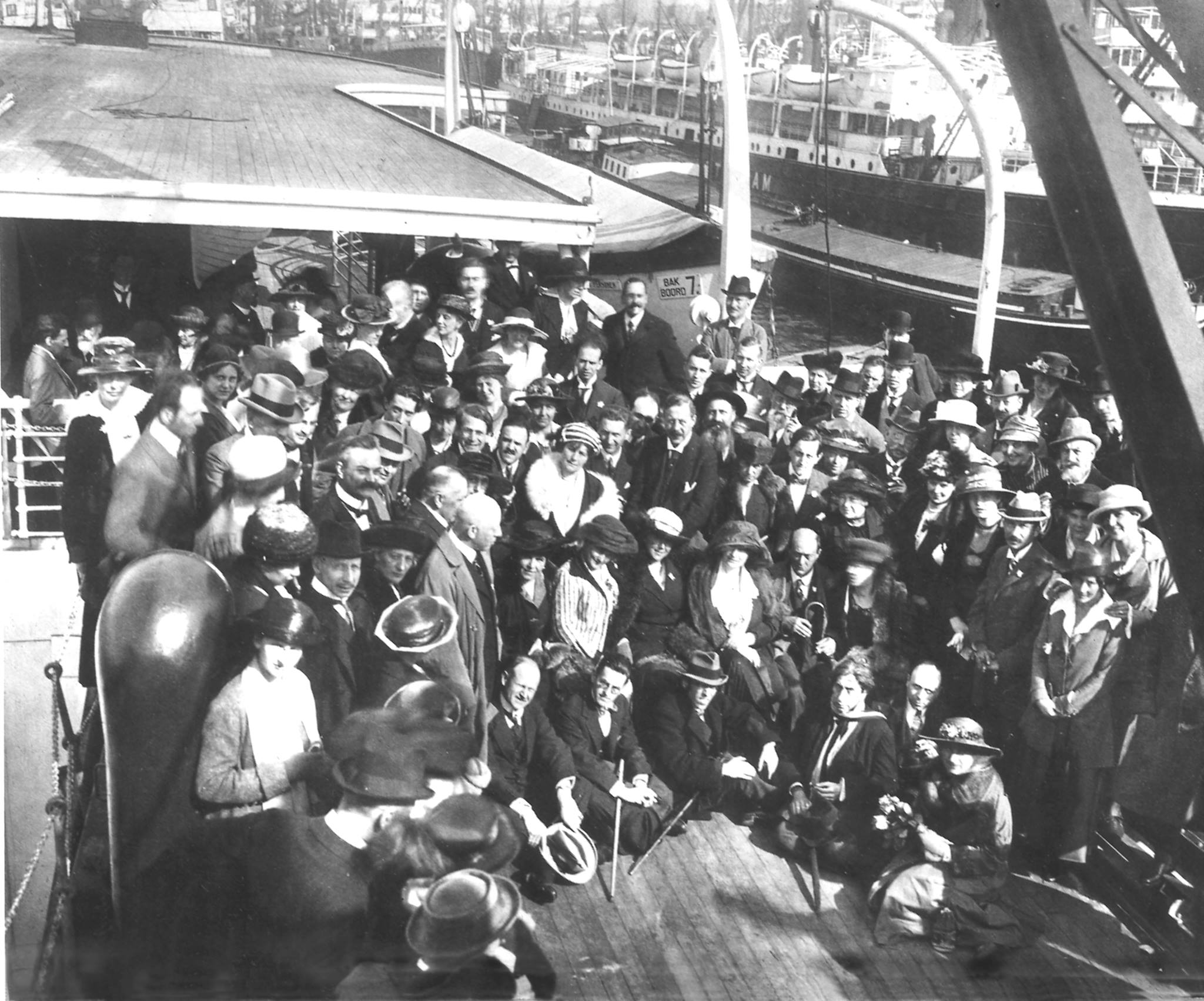
13-05-1920. Gustav Mahler Festival Amsterdam 1920. Aboard S.S. Jan Pieterszoon Coen.
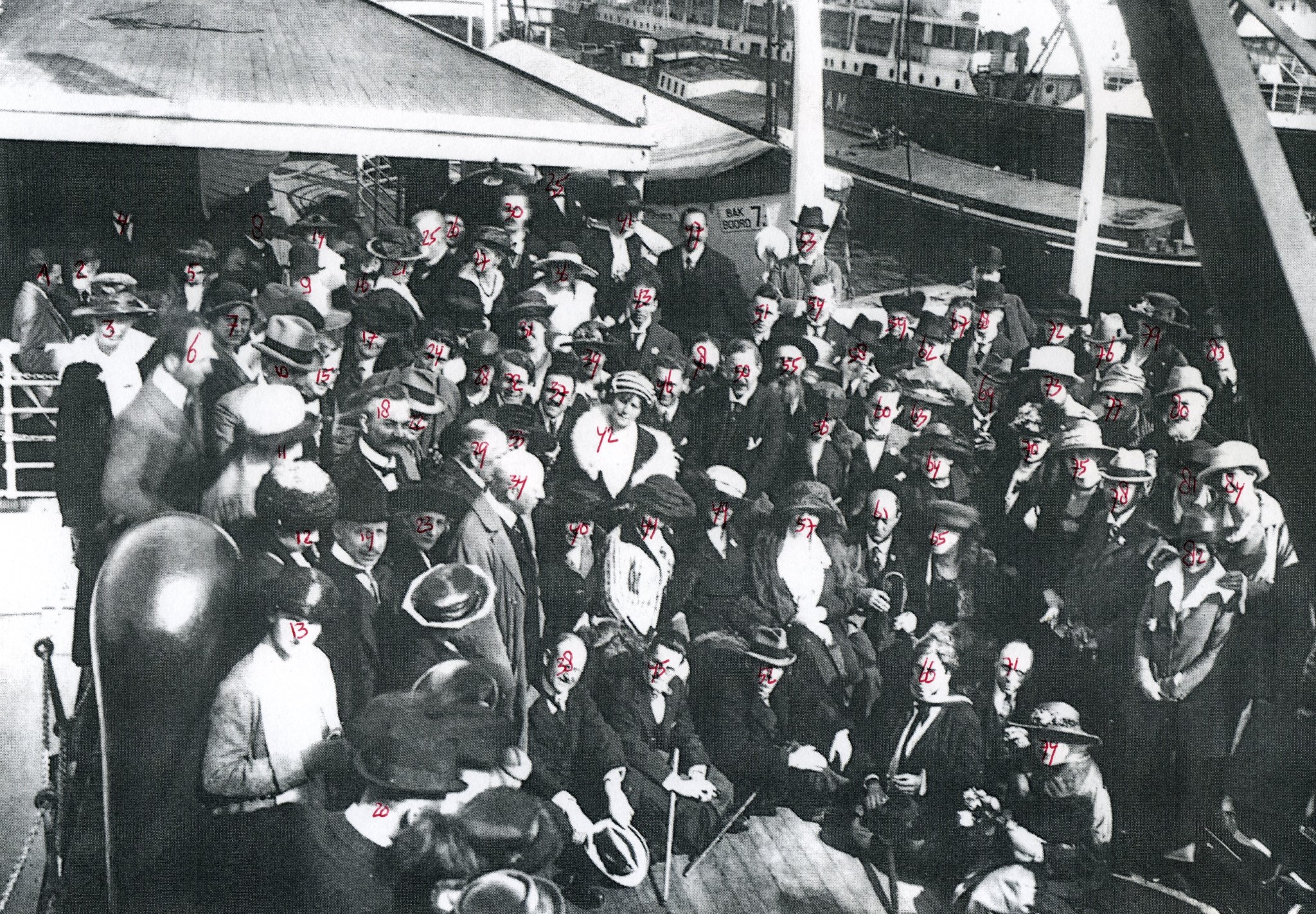
13-05-1920. Gustav Mahler Festival Amsterdam 1920. S.S. Jan Pieterszoon Coen.
Identifying numbers:
- 22 = Egon Wellesz (1885-1974)
- 24 = Alban Berg (1885-1935) (?).
- 44 = Gertrude Foerstel (striped dress).
- 49 = Mathilde Mengelberg-Wubbe (1875-1943) (white hat).
- 52 = Alexander Schmuller (1880-1933).
- 57 = Alma Mahler (1879-1964) (dark hat, dark scarf).
- 60 = Willem Pijper (1894-1947).
- 61 = Arnold Schoenberg (1874-1951)(dark hat, pin and umbrella).
- 65 = Mathilde Schoenberg.
- 66 = Richard Specht (1870-1932).
- 67 = Anton Webern (1883-1945 (?)
- 71 = Leonid Kreutzer (1884-1953).
- 74 = Mrs. Richard Specht (1870-1932)
- 80 = Carl Julius Rudolf Moll (1861-1945).
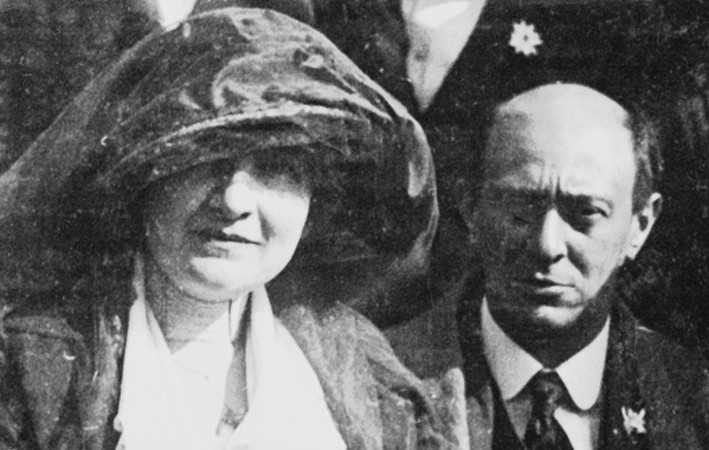
13-05-1920. Gustav Mahler Festival Amsterdam 1920. Alma Mahler (1879-1964) and Arnold Schoenberg (1874-1951). S.S. Jan Pieterszoon Coen.
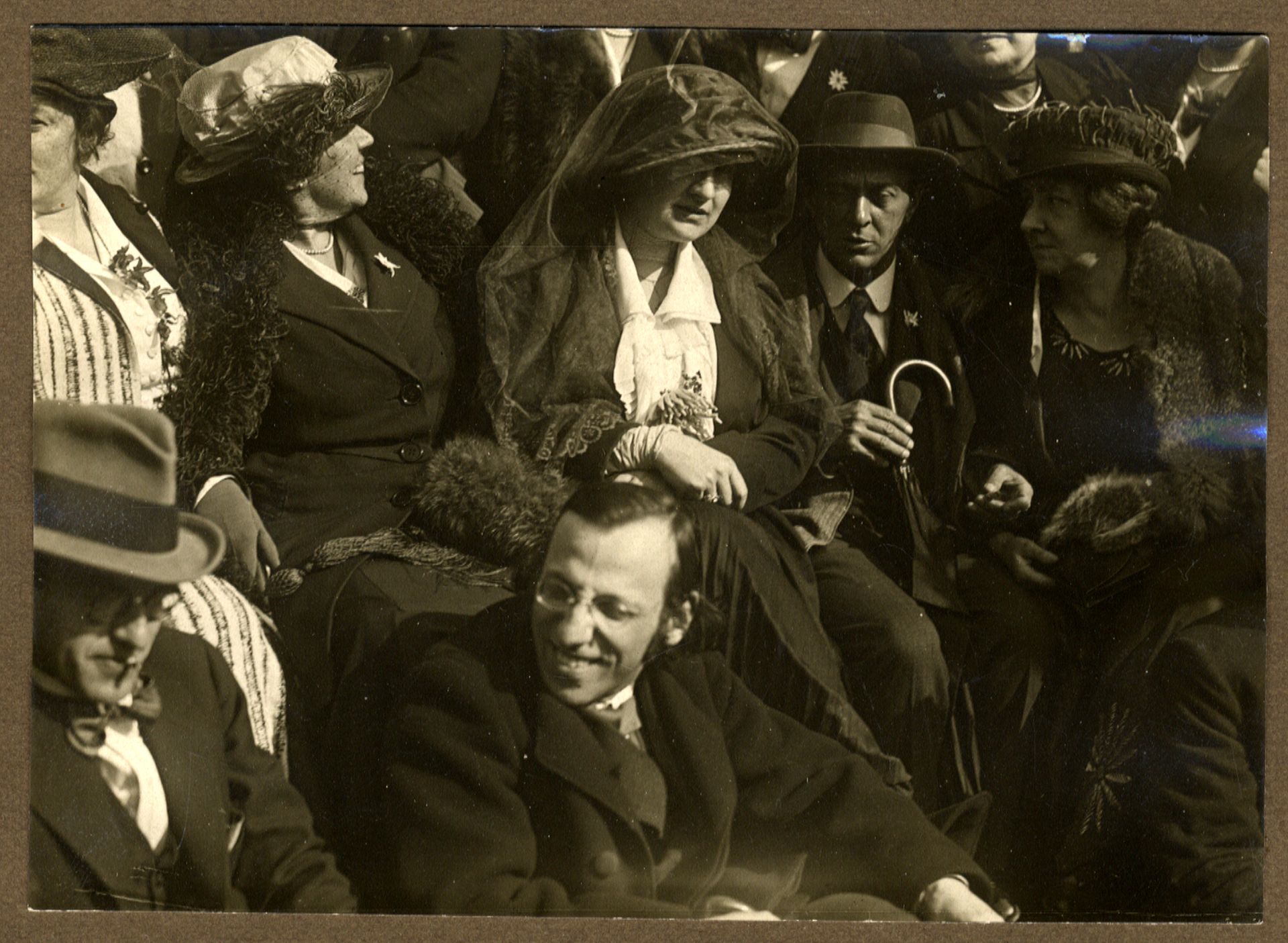
13-05-1920. Gustav Mahler Festival Amsterdam 2020: Gertrude Foerstel (in striped dress), Mathilde Mengelberg-Wubbe (1875-1943) (white hat), Alma Mahler (1879-1964) (dark hat with dark scarf), Arnold Schoenberg (1874-1951) (dark hat, pin and umbrella), Mathilde Schoenberg. In front: Alexander Schmuller (1880-1933). S.S. Jan Pieterszoon Coen.
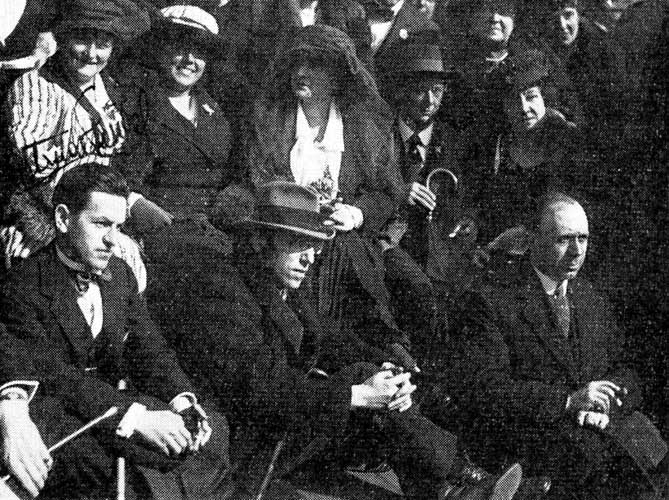
13-05-1920. Gustav Mahler Festival Amsterdam 1920. S.S. Jan Pieterszoon Coen. In front Alexander Schmuller (1880-1933) (middle) and Leonid Kreutzer (1884-1953) (right).
13-05-1920. Gustav Mahler Festival Amsterdam 1920. S.S. Pieterszoon Coen. In front Alexander Schmuller (1880-1933) (middle) and Leonid Kreutzer (1884-1953) (right).
13-05-1920. Gustav Mahler Festival Amsterdam 1920. Sitting: Sigrid Onegin, Alexander Schmuller (1880-1933), Alma Mahler (1879-1964), Gerrit Hendrik de Marez Oyens (1811-1883), Sarah Charles Cahier (1870-1951), Leonid Kreutzer (1884-1953). Standing in the back: S.A.M. Bottenheim (left) and Joseph Groenen (middle). S.S. Pieterszoon Coen.
13-05-1920. Gustav Mahler Festival Amsterdam 1920. Arnold Schoenberg (1874-1951), Alma Mahler (1879-1964) and Mathilde Schoenberg in Amsterdam harbor.
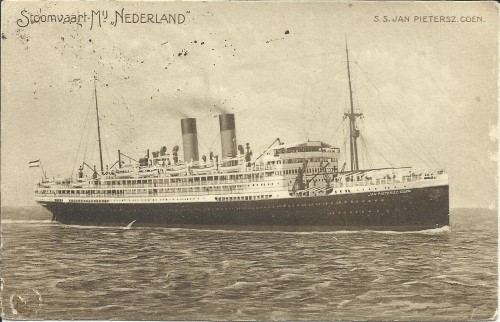
13-05-1920. Amsterdam. S.S. Jan Pieterszoon Coen.
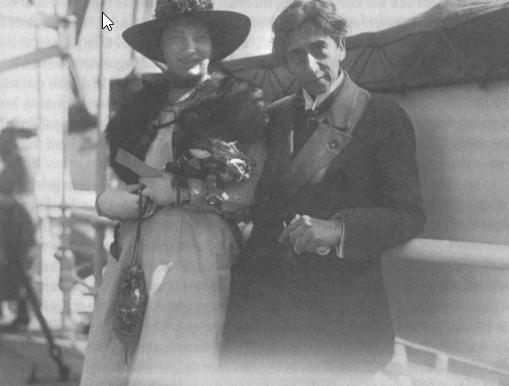
14-05-1920. Gustav Mahler Festival Amsterdam 1920. Richard Specht (1870-1932) and wife.
16-05-1920, 19-05-1920 and 20-05-1920. Gustav Mahler Festival Amsterdam 1920. Gustav Mahler Festival Amsterdam 1920. “International Chambermusic festival during the Mahler Festival”. Concerts organised by Alexander Schmuller (1880-1933). Small hall. Julius Rontgen (1855-1932), Carl Nielsen (1865-1931), Rudolf Mengelberg (1892-1959), Arnold Schoenberg (1874-1951), Amedee-Ernest Chausson (1855-1899).
19-05-1920. Gustav Mahler Festival Amsterdam 1920. Alma Mahler (1879-1964) and Arnold Schoenberg (1874-1951) on a boat trip throught Amsterdam harbours.
19-05-1920. Gustav Mahler Festival Amsterdam 1920. Boat trip. Arnold Schoenberg and F. Wiebaut (Dutch alderman of finances and artistic affairs in Amsterdam). Sitting with hat on the right Carl Julius Rudolf Moll (1861-1945).
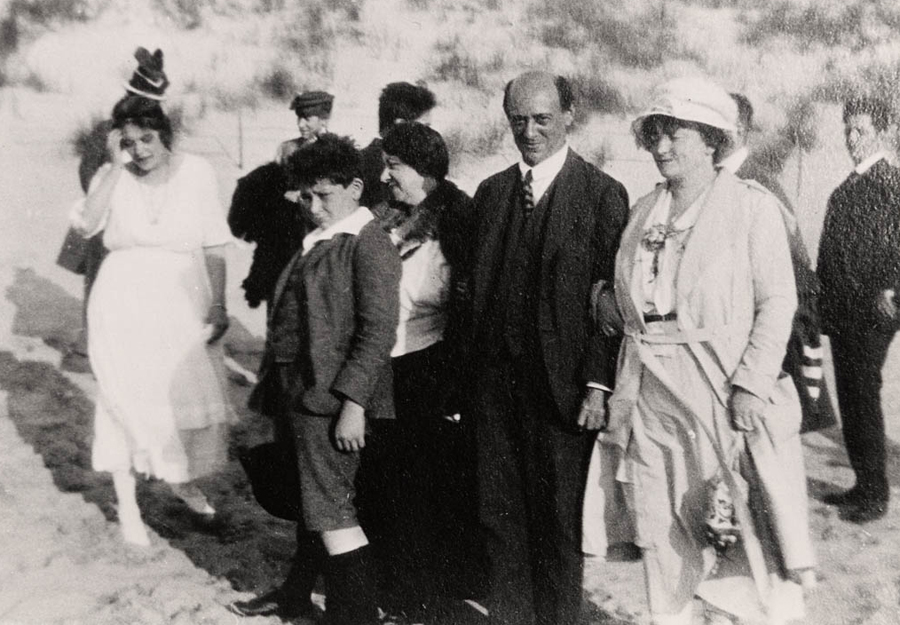
1920. Zandvoort. Gustav Mahler Festival Amsterdam 1920. Anna Justine Mahler (Gucki) (1904-1988)?, Georg Schoenberg, Alma Mahler (1879-1964), Arnold Schoenberg (1874-1951) and Mathilde Schoenberg.
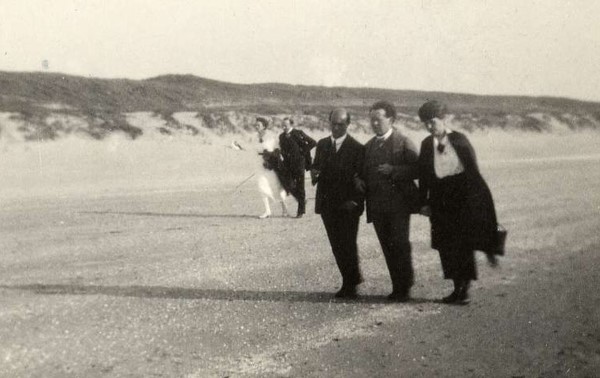
1920. Zandvoort. Gustav Mahler Festival Amsterdam 1920. Mathilde Schoenberg and Richard Specht (1870-1932). Arnold Schoenberg (1874-1951), Willem Mengelberg (1871-1951) and Mathilde Mengelberg-Wubbe (1875-1943).
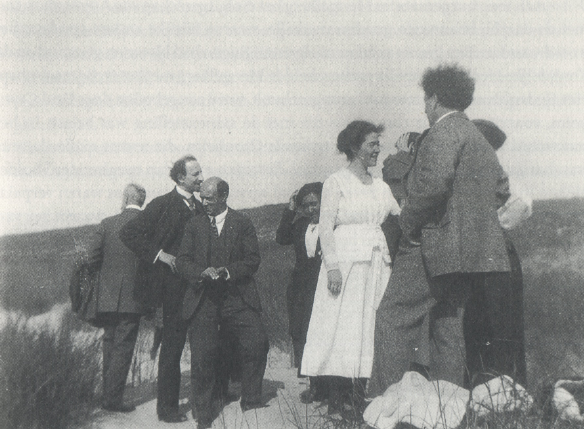
1920. Zandvoort. Gustav Mahler Festival Amsterdam 1920. Arnold Josef Rose (1863-1946)?, Richard Specht (1870-1932), Arnold Schoenberg (1874-1951), ?, Mathilde Schoenberg, Willem Mengelberg (1871-1951) and Mathilde Mengelberg-Wubbe (1875-1943) (in the back).
1920. Erwin Stein (1885-1958), Anton Webern (1883-1945) and Arnold Schoenberg (1874-1951).
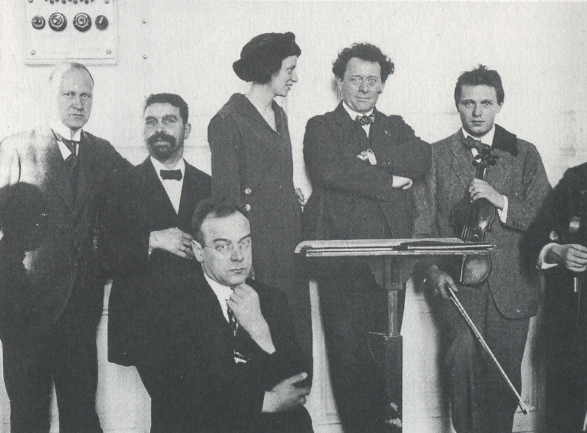
1920. Gustav Mahler Festival Amsterdam 1920. Photo made during a rehearsal for the festival. Hendrik Freijer (1876-1955) (administrator), S. Blazer (member of the Amsterdam Royal Concertgebouw Orchestra (RCO), Cornelis Dopper (1870-1939), Mrs. Busch, Willem Mengelberg (1871-1951) and Adolf Busch.
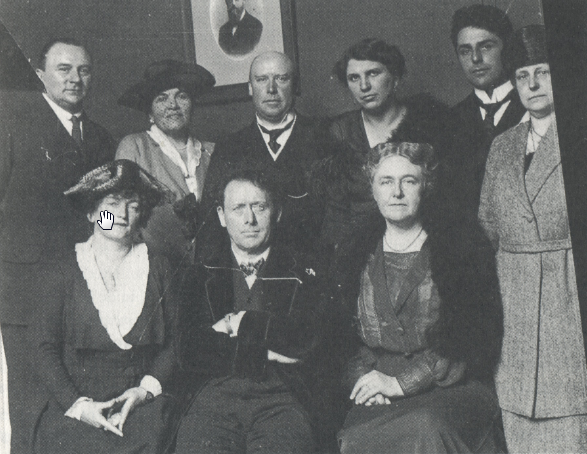
1920. Gustav Mahler Festival Amsterdam 1920. Photo made in the Amsterdam Royal Concertgebouw: Most of the vocalists: Standing: Jos Groenen (baritone), Sarah Charles Cahier (1870-1951) (alto), Jacques Urlus (tenor), Ilona Durigo (alto) and Thom Denijs (bas), Jo Beukers-van Ogtrop (presidente Toonkunst choir). Sitting: Gertrude Forstel (1880-1950) (soprano), Willem Mengelberg (1871-1951), Aaltje Noordewier-Reddingius (1868-1949) (soprano).
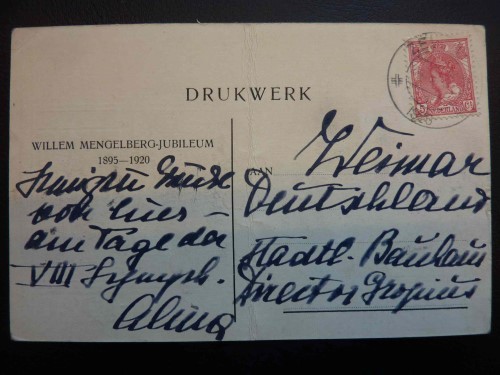
1920. Gustav Mahler Festival Amsterdam 1920. Postcard Alma Mahler (1879-1964) to Walter Gropius (1883-1969) in Weimar. About Symphony No. 8 (21-05-1920).
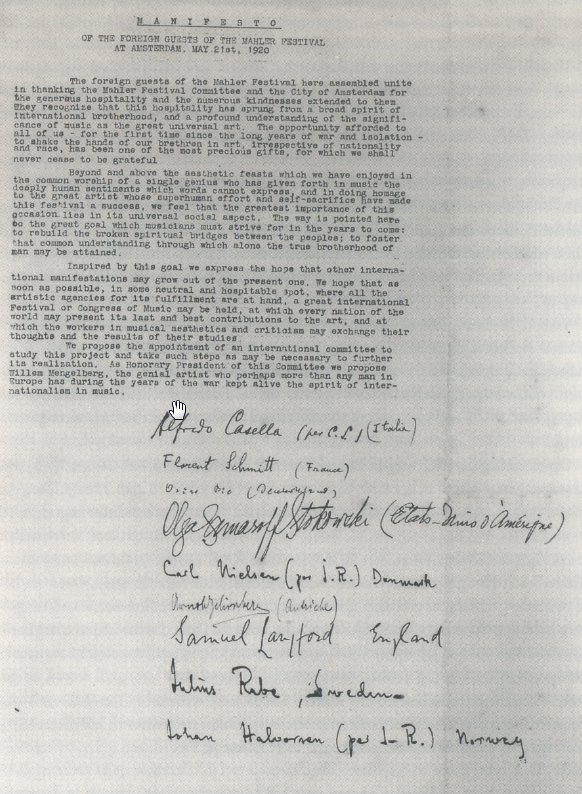
21-05-1920. Gustav Mahler Festival Amsterdam 1920. Manifesto of the foreign guests.
- Italy: Alfredo Casella (1883-1947) (composer).
- France: Florent Schmitt (1870-1958) (composer).
- Switzerland: Oscar Bie (1864-1938) (conductor).
- United states of America: Olga Samaroff Stokowski (1882-1948) (pianist).
- Denmark: Carl Nielsen (1865-1931) (composer).
- Austria: Arnold Schoenberg (1874-1951) (composer).
- United Kingdom: Samuel Langford (1863-1972) (critic).
- Sweden: Julius Rabe (1890-1969) (critic).
- Norway: Johan Halvorsen (1864-1935) (composer).
21-05-1920. Gustav Mahler Festival Amsterdam 1920. Memorial plaque group of three. Location: Amsterdam Royal Concertgebouw, large hall, near entrance left, front of stage. After a speech by Hendrik Freijer (1876-1955), two plaques designed by sculptor Toon Dupuis (1877-1937) (and executed by the firm Begeer) were unveiled with the effigies of Mahler and Mengelberg.
21-05-1920. Gustav Mahler Festival Amsterdam 1920. Royal Concertgebouw, City of Amsterdam, the Netherlands. Memorial plaque 1. Willem Mengelberg (1871-1951).
21-05-1920. Gustav Mahler Festival Amsterdam 1920. Royal Concertgebouw, City of Amsterdam, the Netherlands. Memorial plaque 2. Gustav Mahler (1860-1911).
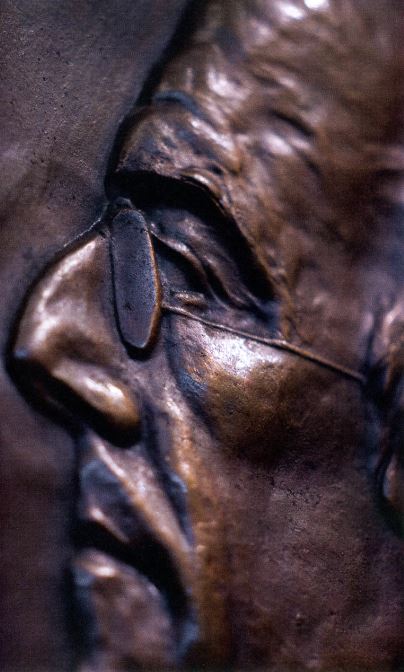
21-05-1920. Gustav Mahler Festival Amsterdam 1920. Royal Concertgebouw, City of Amsterdam, the Netherlands. Memorial plaque 2. Gustav Mahler (1860-1911).
21-05-1920. Gustav Mahler Festival Amsterdam 1920. Royal Concertgebouw, City of Amsterdam, the Netherlands. Memorial plaque 3. Translation from Dutch: “In memory of the Mahler Festival 19.6may21.20 on the occasion of the 25th anniversary of Willem Mengelberg (1871-1951) as director of the Royal Concertgebouw“.
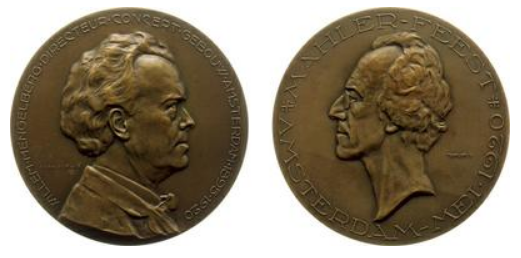
21-05-1920. Gustav Mahler Festival Amsterdam 1920. Bronze Medal by Toon Dupuis (1877-1937), bust of Willem Mengelberg (1871-1951) and Gustav Mahler (1860-1911), 65mm. Willem Mengelberg (1871-1951) gave these to the foreign guests and to some friends.
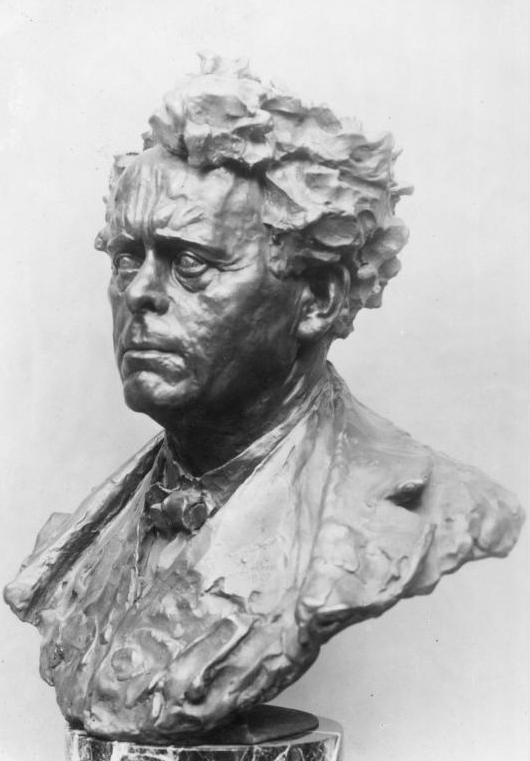
22-05-1920Gustav Mahler Festival Amsterdam 1920. Antonie Roell (1864-1940) offered Willem Mengelberg (1871-1951) a bronze that was made during the festival by the deaf artist Gustinus Ambrosi (1893-1975).
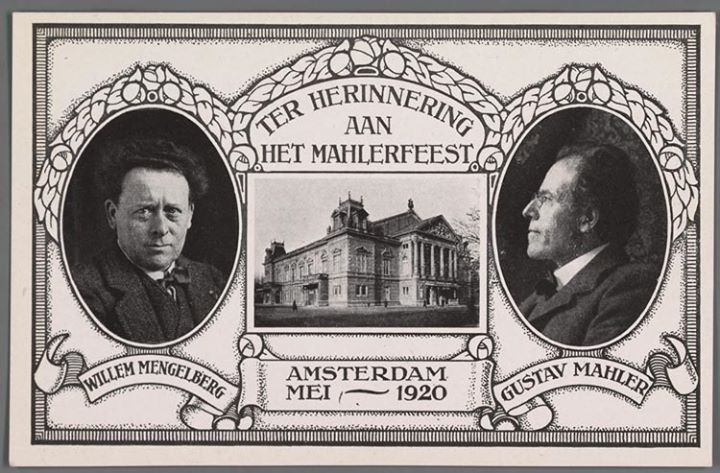
1920. Gustav Mahler Festival Amsterdam 1920. Royal Concertgebouw, City of Amsterdam, the Netherlands. Memorial stone. Royal Concertgebouw. Location: Corridor.
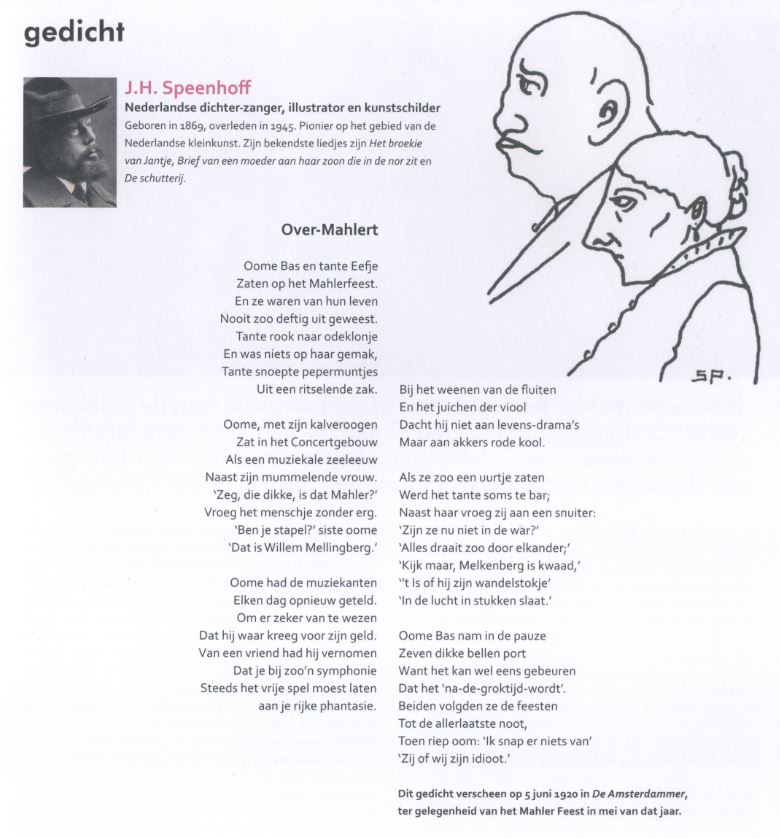
05-06-1920. Poem ‘Over-Mahlert’ by J.H. (Koos) Speenhoff (1869-1945) in ‘De Amsterdammer’ about the Mahler Festival 1920 Amsterdam.
1920. 07-06-1920 Volendam. Boattrip over the Zuiderzee to Volendam offered by Willem Mengelberg (1871-1951) and Mathilde Mengelberg-Wubbe (1875-1943) to the members of the Royal Concertgebouw Orchestra (RCO/KCO) and the members of the administrative staff of the Royal Concertgebouw to thank for the Gustav Mahler Festival Amsterdam 1920.
Patron of the organising committee
Organising committee (1919)
- Prince Henry of the Netherlands (1876-1934).
- Johannes Theodoor de Visser (1857-1932). Minister of Education.
- Antonie Roell (1864-1940). Mayor of Amsterdam.
Organising sub-committee (1919)
- Jo Beukers-van Ogtrop (1865-1948). President of the Amsterdam art show choir.
- Hendrik Freijer (1876-1955). Administrator of the Royal Concertgebouw.
- Rudolf Mengelberg (1892-1959). Cousin of Willem Mengelberg (1871-1951), editor of the programs of Royal Concertgebouw. Partly paid by Willem Mengelberg (1871-1951). Driving force behind the organization of the festival.
Administration
- Travel- and accommodation expenses for the quests where payed by the organising committee. First class train from the Dutch border.
- For guests from abroad permits and visas where arranged.
- On request by the organising committee the Union Netherlands in Foreign Countries arranged excursions for the quests: Visits to the Rijksmuseum and the diamond grindery of the Asscher Company and two boat trips (one through the Amsterdam harbour).
- Commemorative book (preparations started in 1919)
Review
In May 1920, the first ever Mahler festival was held in Amsterdam under the conductor Willem Mengelberg. The Viennese composer Egon Wellesz wrote a detailed report on the events in two separate articles for the Neue Freie Presse which I have translated. One was at the beginning of the festival and the other at its conclusion. It’s not only interesting to read about these early performances at a time before gramophone and broadcasting, but it reminds us of how unstable the world still was. The photograph that accompanies this article shows Alma Mahler in the middle with a broad dark hat and a white blouse and loose wrap with Arnold Schoenberg on the right (her left). Sitting on the floor is Richard Specht (third from the right); Standing in the middle is Egon Wellesz and in the crowd we also see the publisher Emil Hertzka; Egon’s wife Emmy Wellesz; Alma’s step-father Carl Moll; Guido Adler and Anton von Webern. This photo must have been taken on the free day described by Wellesz in the accompanying article. Much of the admiration for Mengelberg and general optimism that was expressed by Wellesz was to be betrayed, as demonstrated in the following post in a letter from Mengelberg’s office to Wellesz in 1949.
17th May, 1920: Neue Freie Presse, Dr. Egon Wellesz
It’s a degree of recognition that no other composer could possibly expect. In the coming days here in Amsterdam, we shall hear the complete works of Gustav Mahler. A sequence of events and coincidences has meant that the combination of a culture-mad citizenry along with the conductor Willem Mengelberg, tireless efforts to establish Mahler, have established Amsterdam as a citadel where his symphonies are cultivated as nowhere else. Thus a circle is completed that started with genius, inflamed a conductor to be the prophet of new, never-heard-before beauty, a new greatness and now having inspired a large community, they in devoted gratitude, return to their provider in order to honour him.
Willem Mengelberg has been conductor of the Concertgebouw Orchestra in Amsterdam for 25 years – he has brought it to a standard that could never have been imagined. One has no feeling of any separation between musicians and conductor; rather together, they form a higher unity that grows closer in the course of performance. This is an understanding that can only develop over a period of decades of mutual hard work and discipline. The best is merely just good enough. This singleness of purpose between conductor and orchestra is even carried over to the public, who over the years have come to understand the works of Mahler as nowhere else – not even in Vienna itself. It was here in Amsterdam that Mahler enjoyed his first, unqualified success; and it was from here that he returned home with new inspiration and a desire to carry out new work. It was here that in 1903 he conducted his 1st and 3rd, in 1904, his 2nd and 4th, in 1906 his 5th, in 1909 his 7th. And if one takes in the number of performances conducted by Mengelberg which were taking place around the same time as those conducted by the controversial Mahler, then once can come to appreciate how it is that the Chorus and the orchestra have become the composer’s own instruments of choice: Amsterdam is to the cultivation and preservation of Mahler’s music what Bayreuth, in its more glorious years, was to Wagner.
* * *
Isn’t it odd that as a Viennese one has to travel to Amsterdam to celebrate Mahler’s 60th birthday? Vienna, which is so besotted with both the arts and artists, simply ignored this event. And it is here in dour but appreciative Amsterdam, that the spirit of Mahler thrives. Everyone here appears to have known him, to have adored and valued him. His eccentricities were met with the healthy respect one brings to such personalities – personalities in which such things are both anticipated and appreciated. The spirit that dwells in his symphonies, the mystic and the religious are deeply felt. The reception here has been open for the broadest arc of his creativity; the significance of the most minute detail followed him here. One maintained in this city, without betraying oneself or one’s artistic opinions, a respectful distance to the artist.
***
Mengelberg was meant to have received a particular recognition from his friends in Amsterdam; instead of personal recognition he requested that Amsterdam be the city where a Mahler Festival could be held to which people from all over the world would come in order the hear all of Mahler’s work in Mengelberg’s definitive interpretation. The still unclear [political] relationships which continue to plague our world today did not seem to represent the slightest hindrance to this goal. The Festival committee took up the challenge with unprecedented generosity. It was decided to make those participants from beyond the Dutch borders Holland’s special guests – they covered the arrangements for travel, accommodation and all expenses – only because of this act of generosity was it possible for us Viennese to attend.
The journey started in a happy mood for our small group of fellow-travellers in the comfortable, not too crowded carriages of the ‘Holland Express’. We crossed all borders without difficulties and arrived without any delays in Amsterdam. We were met by members of the Festival committee who took charge of our luggage and brought us all to our respective quarters: some in hotels and some in private accommodation. The tickets to all of the events were already waiting for us in our quarters, along with the programme. Everything worked perfectly: nothing was forgotten – every need, no matter how trivial was met. The Viennese were met with particular generosity and courtesy. The locals are well aware of the deprivations and difficulties we still suffer in our homeland and have tried their best to make us as comfortable as possible, if only to make their sympathy and understanding clear to us, that even abroad, we are united by a shared, and valued culture. It was in this context that the Viennese were accorded the principal addresses in the opening events.
‘Hofrat’ [Imperial Court Council – a uniquely Austrian title] Guido Adler opened the events with a warmly appreciative speech in Mahler’s memory that touched on the artist and the man. He spoke of their common home and their youthful years together along with their very first departure into the wide world. He spoke about the roots of Mahler’s creativity and its relationship with the nature of the folksong, march rhythms and [militaristic] signal calls that characterise his works. He recalled both the Military and the country-folk poetry that would develop into his Wunderhornlieder.
Paul Stefan gave a lively speech without notes about Mahler the theatre director. He sketched out in short sections what Mahler had contributed to the stagecraft of opera and how he managed to force the visual presentation to ever more fantastic and enchanting images – he outlined everything that he achieved in order to reach never imagined experiences. Both speeches were received with the greatest of sympathy. The third speech was delivered by the Italian Alfredo Casella who has also spent a good deal of time in France. His speech was a profound declaration for a new, international life of the artistic and intellectual spirit. He accentuated how for the first time since the end of the war, people from all countries had come together where the concepts of friend, foe and neutral no longer existed – such was the spirit of Mahler that had been able to create this unity. He concluded with something we all felt: ‘Art has always existed apart from worldly matters. It will no longer be debased or exalted as a means of propaganda that supports or defiles different peoples. Humanity now unites those who previously had called each other enemies. To the ruthlessness of warfare that had previously broken all spiritual bonds and after the flood of hate and distrust had now appeared the dove of peace.
***
One arrives in the auditorium of the Concertgebouw for the very first festival event. The podium is covered with wreaths of red azaleas and laurel trees have been placed behind the seating for the chorus that surrounds the orchestra. At the very front is a bust of Mahler. Mengelberg walks out to applause that last many minutes, followed by a vacuum-like silence. He makes a gesture and the chorus rises without a sound. A sharp wrap of the baton and we hear the opening of ‘Das klagende Lied’.
A rehearsal with Mengelberg: the hall is divided from the stage by a large curtain – where normally the chorus are sat, we find musicians and conductors from everywhere in the world, whom Mengelberg has specially invited to observe him at work. It is only here since Mahler’s own lifetime that it is possible to experience what a rehearsal of one of his works should be. External perfection is demanded and any passage that even slightly sounds shoddy is repeated. After the general rehearsal, Mengelberg meets the strings the following day to rehearse a particular figure in the first violins with the concert master. At another point, he brings in the celli and rehearses a cantilena passage until he achieves the intensity of desired expression. There was never a loud or discourteous word. The orchestra knows that everything he demands is fully justified and yields without question to his will.
***
Mengelberg’s significance in this city is felt in the manner by which all of Amsterdam is caught up in the spirit of the festival. The music shops all offer scores of Mahler symphonies in their displays, and the book stores all offer copies of a publication in honour of Mengelberg, meant as a permanent manifestation of what he has achieved. The original consists in its entirety of 7 volumes of testimonies, (including a volume of drawings), by musicians and important personalities of his time. It was presented to him in special chest designed by [Jan] Toorop, which now holds pride of place in his home, itself a tiny museum filled with paintings, woodcuttings and stained glass. One notes that the influence of this man extends well beyond his own discipline as conductor. His mere presence has had a galvanising and determining effect on all the local arts. He is an educator in the highest meaning of the word; both servant to the work and its creative interpreter. He has taken on a responsibility, the successful execution of which was doubted by many. Nevertheless, he seems to have managed it and without fatigue. As proof, on every second day from the 6th to the 21st of May he will perform a work of Mahler. It is this work of love and indeed piety with which he will build his most lasting monument.
*****
31st May, 1920: Neue Freie Presse; Dr. Egon Wellesz
This is the very first time that one has the opportunity of becoming acquainted with the complete works of Mahler. It is the most difficult of all cycles to pull off. Only a very few will last the course. All weakness will be doubly felt, all the limits of talent will be unforgivably apparent. So much of devoted relevance has been written already throughout this journey that I feel that I can save myself the words needed to express thoughts on each individual work, by relating instead the totality of the experience. One thing that must be first stated is that Mahler’s works come into sharper relief through their cyclic performance. One work simply prepares us for the next without one overshadowing the other. One experiences an upward journey from the first piece to his ninth symphony and there is not one work that one would feel did not belong in its rightful place. What both Mengelberg and his orchestra have accomplished in these last days borders on the incomprehensible.
One of Germany’s leading conductors said to me after a performance, that he would rather give up altogether after experiencing such accomplishment. But the musicians are also aware of their unique central role, amongst the Viennese Arnold Schoenberg, who attended each and every rehearsal. And there were other representatives from America, Sweden, Norway, Germany and Italy. The precision of the bowing under the concertmaster Zimmerman and the warmth of sound were astonishing. The moment Mengelberg hears the slightest discrepancy, he responds with ‘Systematic!’ which means ‘not good’. At this point, he starts to rehearse without mercy each and every individual tone and every point within the phrasing. ‘System’ is the word that encapsulates his method with the orchestra over the last 25 years. In reality, ‘system’ is simply a means of achieving exactness in execution, not losing one’s head and to maintain a consistent pulse and tempo. For our ears, we find the oboes sound very strange. They have a strong nasal sound and are weaker in dynamic than our Viennese instruments. The flutes on the other hand are dignified and full-sounding; trumpets and trombones are excellent. Another extraordinary brass player is the bass tuba, who wears gloves in order that his fingers not have direct contact with the keys of his instrument.
Mengelberg’s conducting gestures are precise. He beats sharply and energetically with the right hand. His left, often balled in a fist, is used for conveying expression and indicating entrances. He reaches climaxes by swinging his entire, rather small body about before this hot-head rises above proceedings. He has an agreeable manner of dealing with his orchestra which comes from many years working in mutual trust and understanding with the same people. Occasionally, the atmosphere in rehearsals seems to balance on a knife-edge, at this point, he tells a joke and rescues the situation. He rehearses long stretches and only afterwards does he tell the orchestra what he wishes to change. He not only explains the technical, he tells the orchestra what the individual intentions of the composer were. When he speaks with his sonorous, resonant voice, nobody else makes a sound. One senses an inner contact, and it is in this manner that he can achieve the best results from his players — just as a virtuoso gets the best out of his instrument. They tune precisely and co-operate through each rehearsal of a transitional passage. Nobody thinks of marking during rehearsal – Mengelberg demands full sound at all times and the highest degree of tension and concentration. One of the typical rehearsal programmes went along the following lines:
From 09:00 until 13:00, he rehearses the 4th and 5th symphonies. In the evening, there are rehearsals of the 9th and 5th from 20.00 to 22.00. At 22.00, he rehearses the chorus for the 8th symphony while the second concert master rehearsed the Adagietto from the 5th. He makes sure that the musicians are rested during their breaks. They’re given milky coffee and an endless supply of cheese sandwiches. After rehearsals, Mengelberg returns home and studies the scores for the next day’s rehearsals until deep in the night.
Yet there is nothing that is taken for granted on his part. He gets up in the morning, refreshed and must re-establish his authority from zero – he betrays no sense of entitlement by replacing his attempts to achieve expression by mere routine. For us who have come to observe, it’s a revelation the way he can create tension without snapping and elicit emotion without losing control. These festival performances are unique. They have never been matched in the devotion shown by those giving the performances or those attending them. Any attempt at repeating such a venture will be doomed to failure – if there is a repetition of such an undertaking, it would demand an entirely different approach. It is the first time that we have the entirety of Mahler’s work separated from its creator and finally launched into the wider world. Mahler no longer belongs just to Vienna, to Austria or to Europe, but has now been handed over to the entire world. For example: this winter, the 8th symphony will be performed in New York, and Mengelberg will continue to present Mahler’s works in various other American cities. This elementary effect of Mahler’s music on the masses of music lovers must come as a surprise to those who had admired him from the very beginning. But that his day of musical resurrection would be so soon – well none of us could ever have anticipated it.
***
Amsterdam’s Mahler Festival is set chronologically with performances of his symphonies and orchestral songs and can be heard over nine evenings’ of performances to which may be added four public rehearsals and five performances of international, contemporary chamber music. The performances start in Amsterdam at 19:30 and carry on until 22:30 or even 23:00. In the first concert on the 6th of May, we heard ‘Das klagende Lied’, ‘Lieder eines fahrenden Gesellen’ and the 1st Symphony. One could not have heard a more complete version of ‘Das klagende Lied’ even under Mahler himself. This work of exuberant youthful talent, orchestrated by the experienced composer, was offered to devastating effect. Just as surprising in its impression, was the effect of the last movement of the 1st Symphony, which many, including myself, regarded until the present performance as one of his weakest works. Mengelberg knew how to draw the pieces together in order to create an entirely different picture.
The next day brought us the lectures about Mahler that we have already reported as well as a general rehearsal of the 2nd Symphony. This was followed the next day with a performance that will never be forgotten by those who were present and able to appreciate the mystery and quietness of the chorus’s entrance: ‘Arisen – yes! Arisen!’ after the call in the horns and the trumpets. Nor can we forget the performance of ‘Urlicht’ or the powerful surge of the final when Mengelberg extracted the final reserves of both chorus and orchestra.
The performance of the 3rd Symphony on Monday the 10th of May resulted in a particular celebration for Mengelberg. The Prince Consort Heinrich handed over both laurel and floral wreaths and was introduced to both visiting and local music lovers, all of whom had made the effort to honour the life and work of Gustav Mahler. The fourth Festival concert on Wednesday the 12th of May brought us the 4th and 5th symphonies. The latter, in Holland as in Vienna, one of the most seldom performed. Yet under Mengelberg’s direction, it left an exceptional and lasting impression. The 4th on the other hand was met as more of a ‘succès d’estime’. The combination of both symphonies in a single evening’s performance was a challenge to any public while at the same time offering a unique opportunity of comparing the two works. It is apparent that in the 4th symphony, Mahler can be heard departing from the style of his earliest works as he begins to become more polyphonic. Within the 5th symphony, this principal has already developed masterly.
The following day was completely free and brought both performers and listeners a well needed period of respite. The afternoon we set out togehter to view an Indian steam ship which offered an opportunity of viewing the local harbour in the course of its day-to-day activities as we watched the arrival of freighters, no doubt returning from the colonies in order to unload their goods. Everything appeared to be a part of a greater whole and offered the impression of a population that semed to have survived the scorched earth of recent years and now, with double energy was bringing different nations together with a broader cultural mission.
One anticipated the performance of the 6th symphony with a certain anxiousness. This work is also less well known in Amsterdam than its predecessors and ‘Das Lied von der Erde’. And again, we experienced a triumph. If I recall the first performance of this work in Vienna under Mahler, I sense that here, the percussion and brass are softer – indeed almost muted in comparison. The last movement, which must be one of the greatest and most plastic of any within Mahler’s symphonies, was particularly rewarding under Mengelberg’s direction. He was able to control the steady development to the climax by unyielding control and instrumental balance, never arriving too soon, and splendidly unravelling the dense knot of musical subjects.
The 7th symphony has a very special place for Mengelberg as he owns Mahler’s manuscript and sees it very much as ‘his’ symphony. However, there are many inward connections that give this symphony its own Amsterdam attachment. Mahler’s first ‘Nachtmusik’ was inspired by Rembrandt’s ‘Night-Watchman’. Mengelberg explained to the orchestra that the music is not to be understood by the painting itself, but in the sequence of visions that viewing the picture unleashed in Mahler: A nightly round; moonlight on the rooftops of the city; lovers whispering; the distant sounds of a herdsman’s bells. Mengelberg explained the meaning of the work – the technical aspects have long been settled. Two weeks before the performance he handed over to his trusted deputy Dopper both the strings and brass so that could be rehearsed separately and prepared to the point that Mengelberg needed only to file away a few rough edges, thus adding wings to the work’s spirit.
Following the performance of the 7th, the chronological sequence of works was disrupted in order to accommodate the technical requirements demanded of the 8th Symphony. There followed therefore the most transfigured of Mahler’s works: ‘Das Lied von der Erde’ and the 9th Symphony, the performance of which fell on the day commemorating Mahler’s death. It is not possible to express in words the reverence that was demonstrated by this performance, the mystical transformation of the musicians. With the sound of the last note resonating in the hall, there followed only silence, which was maintained as we departed from the auditorium.
The monumental highpoint of the festival was the grandiose performance of the 8th symphony. The first violins were led by Carl Flesch, the violas by Adolf Busch. The first soprano was as ever Mrs. Gerturd Förstel; 2nd soprano was Mrs. Noordewter-Reddingtus; the altos were Mrs. Cahier and Mrs. Burigo, the tenor Mr. Urlis. At the piano sat Leonid Kreutzer (1884-1953). Again, there were endless rehearsals that went on until deepest night, and involved wboth chorus and orchestra. These were followed by individual rehearsals with the soloists, with the harps and with the piano. All stood in the grip of the transcendental, indefatigable power of Mengelberg and everyone marvelled and allowed him to do with them as he wished.
In addition to the fullness of the symphonic performances were added five chamber performances on the free-days in-between. These took place under the direction of Professor Alexander Schmuller (1880-1933) and in organisation with the pianists Lamond, Leonid Kreutzer (1884-1953), Schnabel, Mrs. Stokowski and Moritz Löwensohn, the marvellous cellist. Together, they presented a series of representative contemporary chamber music recitals consisting of works by, amongst many others, the Italian composer Casella, the Frenchman Florent Schmitt, and an important vocal work by Artur Schnabel.
An additional two lectures were offered to bring the work and person of Gustav Mahler closer to the public. Felix Salten gave us a graphic depiction of the atmosphere that Mahler’s work elicited and the role that was played by both his person and the city of Vienna; Richard Specht, the trusted biographer of Mahler, spoke of the artist and the triumphs of his vision, which Mengelberg has so visibly transmitted to us all in recent days. It has been agreed that these lectures will be kept as a perpetual memorial to this festival in Amsterdam and are to be published.
***
There is something special about the performance of works in the context of a festival. While we experienced these days, we already sensed the memory of earlier performances slipping away, only to remain as something we cannot describe. Yet despite this, something permanent survives that will bind all of us together as we go our separate ways throughout the world.
That this event could take place at all is thanks to the committee led by Antonie Roell (1864-1940), Richard van Rees (1853-1939) and Jan Dudok van Heel (1867-1930). For the production and presentation of the programme along with the writing of the accompanying notes we thank Mr. Rudolf Mengelberg, who also organised the guest lists and events. For the administration of the festival, we thank Mr. Benkers van Ogtrop and Mr. Frejer along with Mr de Marez Oyens.
***
For us Viennese, this was not only an enormous gain artistically, but also a display of great humanity. One was again surrounded by friendship and love. The generosity of our hosts was such that we could again believe in the words [of Schiller, set by Beethoven in his 9th Symphony] ‘Alle Menschen werden Brüder, wo dein sanfter Flügel weilt.’ The shared goal of something artistic brought us out of, and beyond ourselves and created an atmosphere of artistic and profound seriousness. That this could happen, we are indebted to the man who is Mengelberg and his circle of supporters and friends.
May the spirit of goodness that came from this place continue to support all that is beautiful so that people are once again bound together in everlasting friendship.
Special sources
- Book on Alma Mahler (1879-1964) and Arnold Schoenberg (1874-1951) by Haide Tenner.
- Carl Julius Rudolf Moll (1861-1945)‘s memories.

